Getac Technology PS535F PDA User Manual User s Manual EN
Getac Technology Corporation PDA User s Manual EN
Users Manual

PS535F
2009/12
Trademarks
Microsoft, Windows, the Windows logo, Windows Media, Outlook and
ActiveSync are registered trademarks or trademarks of Microsoft Corporation in
the United States and/or other countries. Microsoft products are licensed to
OEMs by Microsoft Licensing, Inc., a wholly owned subsidiary of Microsoft
Corporation. The Bluetooth word mark and logos are owned by the Bluetooth
SIG, Inc. All other brand and product names are trademarks or registered
trademarks of their respective companies.
Disclaimer
Specifications and manuals are subject to change without notice. GETAC
assumes no liability for damage incurred directly or indirectly from errors,
omissions, or discrepancies between the device and the manuals.

i
Table of Contents
Table of Contents .................................................................................. i
1 Getting Started ............................................................................... 1
1.1 Identifying Hardware Components ...................................................... 1
Front Components ............................................................................... 1
Back Components ............................................................................... 3
Left-Side Components ......................................................................... 4
Top Components ................................................................................. 5
Bottom Components ............................................................................ 5
1.2 Getting Your Device Ready for Use .................................................... 6
Installing the Battery ............................................................................ 6
Performing Initial Startup ..................................................................... 7
Connecting to AC Power and Charging the Battery ............................ 8
1.3 Synchronizing with Your Computer ..................................................... 9
Installing ActiveSync or WMDC ........................................................... 9
1.4 Using an SD/SDHC/MMC Card ......................................................... 11
2 Basic Skills ................................................................................... 12
2.1 Power Saving and Turning Off .......................................................... 12
Backlight Off ...................................................................................... 12
Entering the Suspend Mode .............................................................. 12
Turning Off ......................................................................................... 12
2.2 Using the Stylus ................................................................................. 13
2.3 Using the Navigation Stick ................................................................. 13
2.4 Today Screen .................................................................................... 14
Landscape View ................................................................................ 14
2.5 Navigation Bar and Toolbar ............................................................... 15
2.6 Running Programs ............................................................................. 16
2.7 Shortcut Menus .................................................................................. 16
2.8 Notifications ....................................................................................... 17

ii
2.9 Entering Information .......................................................................... 17
Entering Text Using the Input Panel .................................................. 17
Writing on the Screen ........................................................................ 19
Drawing on the Screen ...................................................................... 20
Recording a Message ........................................................................ 20
2.10 Locking Your Pocket PC .................................................................... 22
3 Managing Your Pocket PC .......................................................... 23
3.1 Managing Power ................................................................................ 23
Low Battery Signals and Actions ....................................................... 23
Power-Saving Tips ............................................................................. 24
3.2 Customizing Your Pocket PC ............................................................ 25
3.3 Searching and Organizing Information .............................................. 27
4 Microsoft Pocket Outlook ........................................................... 28
4.1 Calendar: Scheduling Appointments and Meetings .......................... 28
Creating an Appointment ................................................................... 29
Using the Calendar Summary Screen ............................................... 30
4.2 Contacts: Tracking Friends and Colleagues ..................................... 31
Creating a Contact ............................................................................. 31
Using the Contacts Summary Screen ............................................... 32
4.3 Tasks: Keeping a To Do List ............................................................. 33
Creating a Task ................................................................................. 34
Using the Tasks Summary Screen .................................................... 35
4.4 Notes: Capturing Thoughts and Ideas ............................................... 36
Creating a Note .................................................................................. 37
4.5 E-mail: Sending and Receiving E-mail Messages ............................. 38
Synchronizing E-mail Messages ....................................................... 38
Connecting Directly to an E-mail Server ............................................ 38
Using the Message List ..................................................................... 39
Composing and Sending Messages .................................................. 40
Managing Email Messages and Folders ........................................... 41
5 More Programs ............................................................................ 42
5.1 Microsoft ActiveSync ......................................................................... 42
Synchronizing Data ............................................................................ 43
5.2 Office Mobile ...................................................................................... 44
Creating an Office File ....................................................................... 44
Opening an Office File ....................................................................... 45
5.3 Windows Live Messenger .................................................................. 46
Setting up Windows Live ................................................................... 46
Signing in to Messenger .................................................................... 46
5.4 Using Internet Explorer Mobile .......................................................... 47

iii
Browsing the Internet ......................................................................... 48
5.5 Windows Media Player for Pocket PC ............................................... 49
5.6 Pictures & Videos .............................................................................. 50
5.7 Camera .............................................................................................. 51
Taking Pictures .................................................................................. 51
Recording Video Clips ....................................................................... 53
Camera Controls, Options, and Settings ........................................... 54
5.8 Additional Programs .......................................................................... 55
E-Compass ........................................................................................ 55
TacLink .............................................................................................. 57
6 Getting Connected ....................................................................... 59
6.1 Wireless Network Connection ........................................................... 59
Turning On and Off the Wi-Fi Radio .................................................. 59
Connecting to a Wireless Network .................................................... 60
Starting and Ending the Wireless Network Connection ..................... 60
6.2 Bluetooth Feature .............................................................................. 61
Turning On and Off the Bluetooth Radio ........................................... 61
Transferring Files via Bluetooth Technology ..................................... 62
Bluetooth Partnership ........................................................................ 63
7 Troubleshooting and Maintenance ............................................ 64
7.1 Resetting Your Pocket PC ................................................................. 64
7.2 Restoring the Factory Default State .................................................. 65
7.3 Troubleshooting ................................................................................. 66
Power Problems ................................................................................ 66
Memory Problems .............................................................................. 66
Screen Problems ............................................................................... 67
Connection Problems ........................................................................ 68
7.4 Taking Care of Your Pocket PC ........................................................ 69
General Guidelines ............................................................................ 69
Travel Guidelines ............................................................................... 70
8 Regulatory Information ............................................................... 72
8.1 Regulations Statements..................................................................... 72
European Notice ................................................................................ 72
FCC CAUTION .................................................................................. 73
8.2 Safety Precautions ............................................................................. 74
About Charging .................................................................................. 74
About the Charger ............................................................................. 74
About the Battery ............................................................................... 75
About the Radio Frequency Exposure ............................................... 75

iv
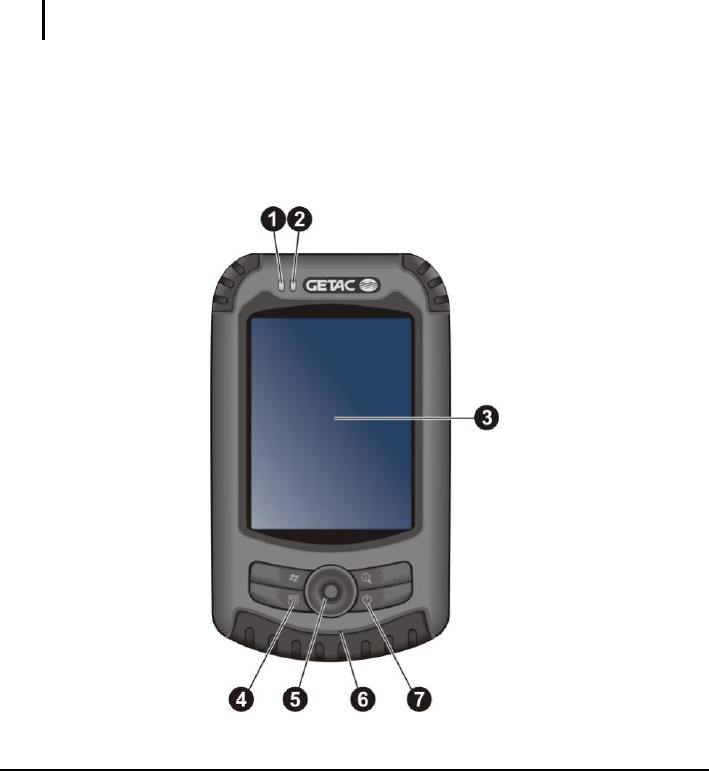
1
1 Getting Started
This chapter introduces you to the external components of your Pocket PC and
guides you through the process of setting up your Pocket PC for use.
NOTE: Depending on the model you purchased, the cabinet color and the look of the
accessories may be different from the ones shown in this manual.
1.1 Identifying Hardware Components
Front Components
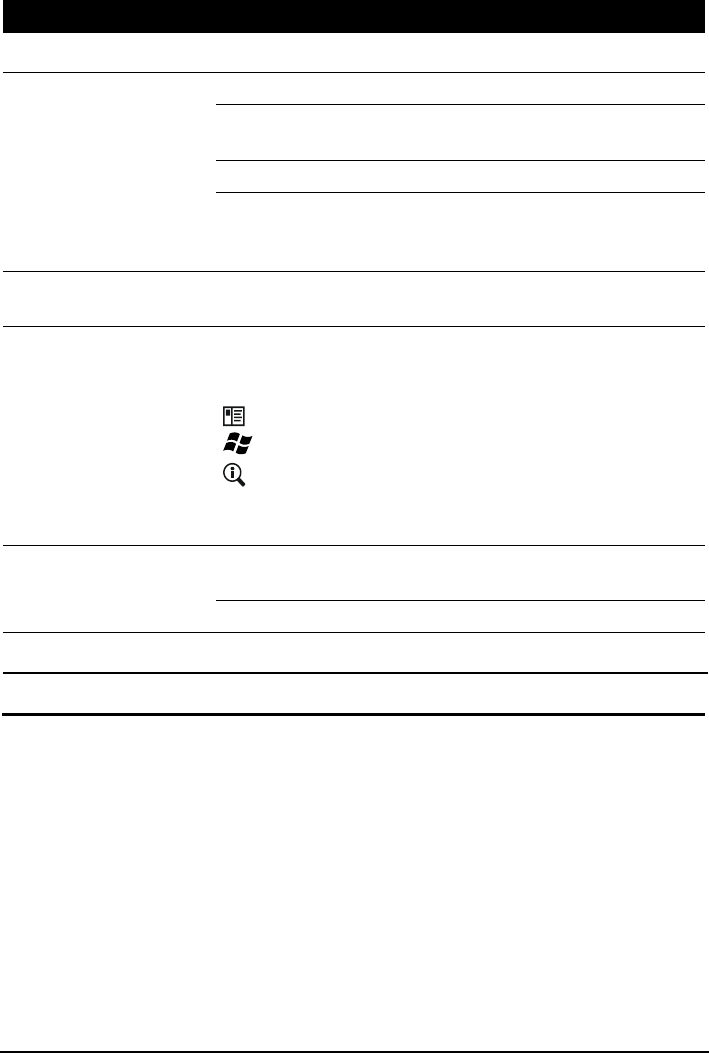
2
Ref
Component
Description
RF Indicator
Glows in blue to indicate that RF is on or active.
Multi-Functional
Indicator
Glows in green to indicate that battery is fully charged.
Glows in amber to indicate that battery charging is in
progress.
Glows in red to indicate that battery power is low.
Flashes in red (when AC adapter is not plugged) /amber/
green alternately (when AC adapter is plugged) when a
notification comes up.
Touch Screen
Displays the output of your Pocket PC. Tap the screen with
the stylus to select menu commands or enter information.
Program Buttons
Each of the three buttons provides a quick way to use a
program or function. The buttons are customizable. The
icons on the buttons indicate the default functions:
Contacts
Start Menu
GPS Application
NOTE: The buttons can provide different functions if you are using
a navigation software that allows you to define the buttons.
Navigation Stick
Moves up, down, left or right by pushing the button toward
the corresponding direction.
Selects by pressing.
Microphone
Receives sound and voice to record voice.
Power Button
Turns your Pocket PC on or off by pressing briefly.
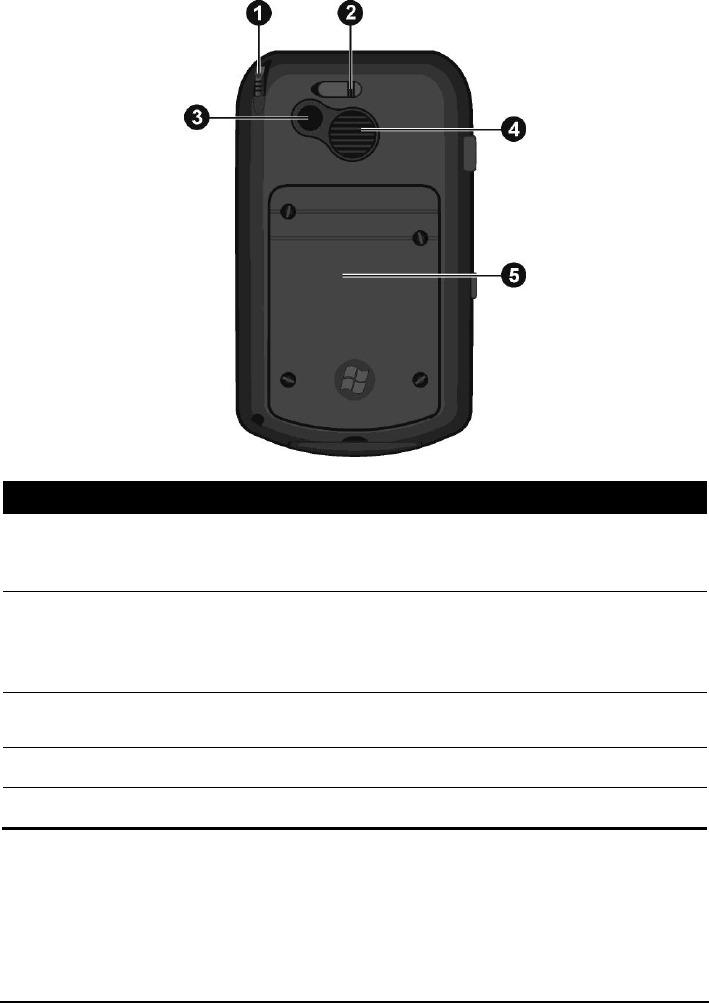
3
Back Components
Ref
Component
Description
Stylus
Tap on the touch screen to make selections and enter
information. Pull the stylus out of its slot to use and store it
in the slot when not in use.
Car Antenna
Connector
This connector (under rubber dust cover) allows use of an
optional external antenna with magnetic mount, which may
be positioned on top of the car for better signal reception in
areas with poor reception.
CMOS Camera
Lens
Allows you to use your Pocket PC‘s camera function.
Speaker
Sends out music, sounds, and voice.
Battery Cover
Inside is the battery.
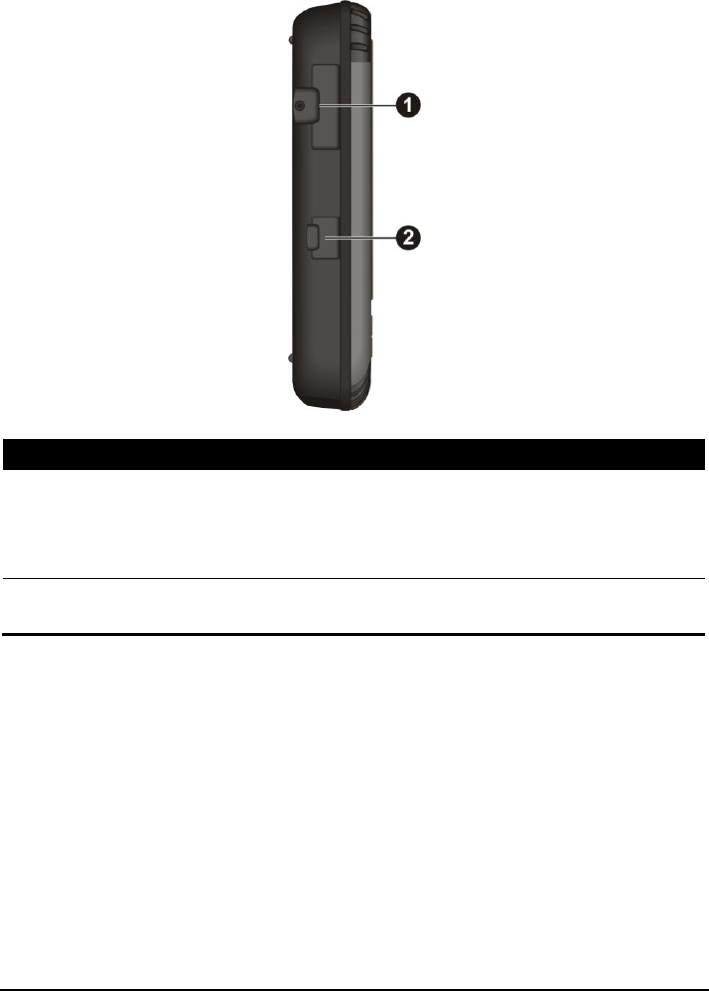
4
Left-Side Components
Ref
Component
Description
SD/MMC Slot
Accepts an optional SD (Secure Digital) or MMC
(MultiMediaCard) card for removable storage.
NOTE: Be sure the rubber cover is tightly closed to prevent
water damage.
Headphone
Connector
Connects to a pair of stereo headphones.
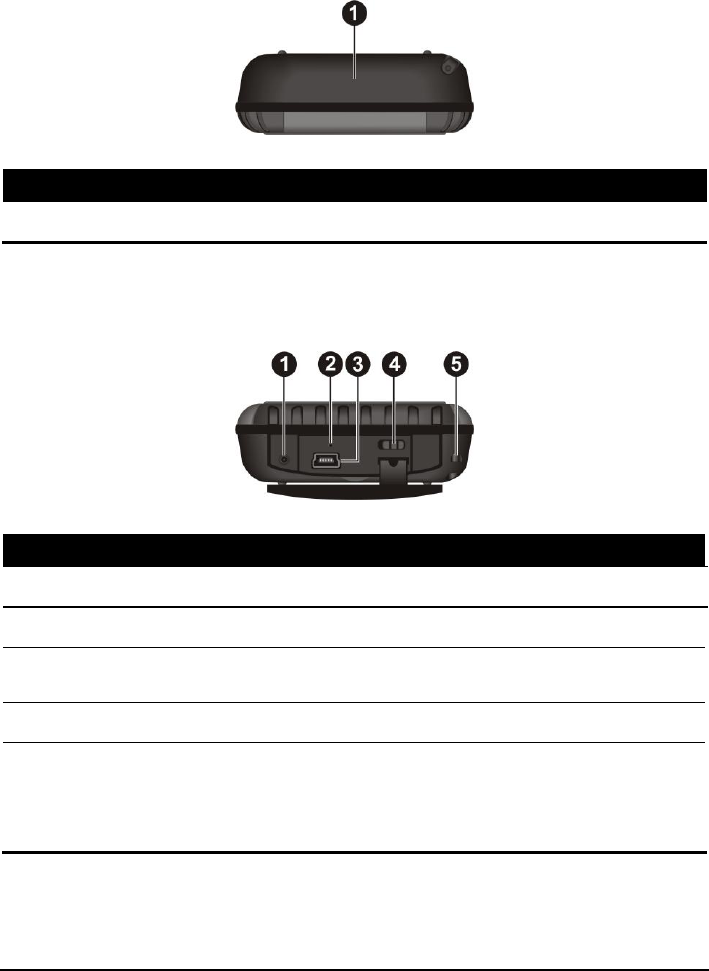
5
Top Components
Ref
Component
Description
GPS Antenna
Receives signals from the GPS satellites overhead.
Bottom Components
Ref
Component
Description
Power Connector
Connects to the AC adapter for charging the battery.
Reset Button
Restarts your Pocket PC.
Mini-USB
Connector
Connects to the USB cable for ActiveSync or charging.
ON/OFF Switch
The main power/battery cutoff switch.
Hand String Hole
Hand string attaches to this hole.
WARNING: Be careful not to allow infants and small children
play with the hand string stopper as this may easily be
swallowed, thereby causing injury or choking.
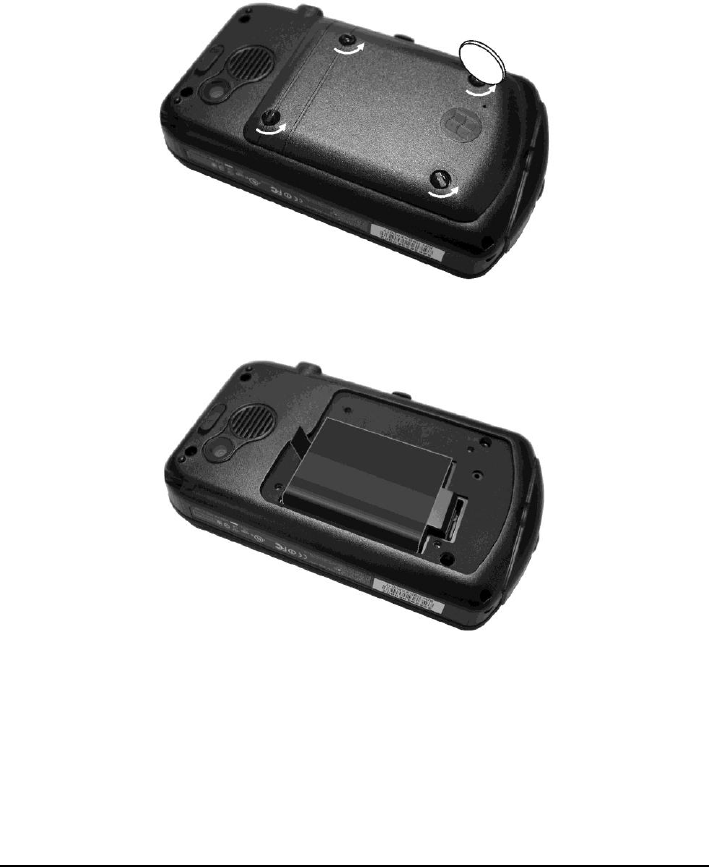
6
1.2 Getting Your Device Ready for Use
Installing the Battery
1. To remove the battery cover, unfasten the four screws using a tool such as a
coin.
2. Fit the battery into place.
3. Replace the battery cover and tighten the four screws.

7
Performing Initial Startup
Initial startup includes setting the ON/OFF switch and completing the setup
wizard.
1. Slide the ON/OFF switch to the ON position.
CAUTION: Always leave the ON/OFF switch in the ON position for normal operation.
2. Your device will automatically turn on. Charge the battery as described in
the next sub-section.
3. Wait for a few seconds until the startup screen appears. Follow the onscreen
instructions to complete the setup wizard. You will then see the Today
screen.
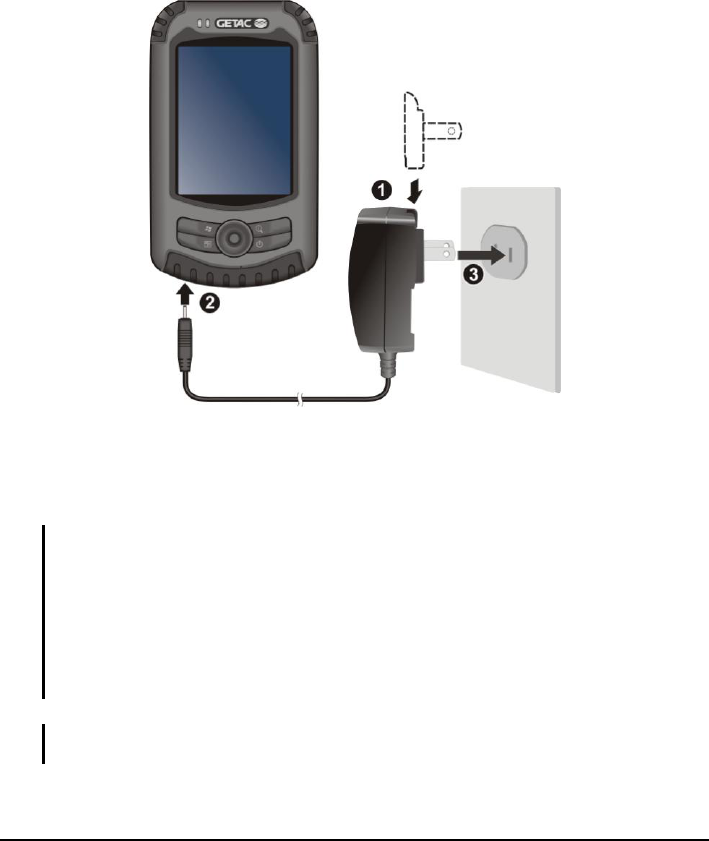
8
Connecting to AC Power and Charging the Battery
When charging the battery for the very first time, charge it for at least 8 hours.
1. Fit the converter plug to the AC charger ().
2. Connect the DC jack end of the AC adapter to your device () and the other
end to a wall outlet ().
3. The multi-functional indicator glows amber when charging is in progress.
Do not disconnect your Pocket PC from AC power until the battery is fully
charged. This will take a couple of hours.
CAUTION: For optimal performance of the lithium battery, take note of the following:
Use the included power adapter (for use with power supply model PC11R-050).
Do not charge the battery where the temperature is high (e.g. in direct sunlight).
There is no need to fully discharge the battery before charging. You can charge the
battery before it is discharged.
If you will not use the product for a long period of time, be sure to fully charge the
battery at least once every two weeks. Over discharge of the battery can affect the
charging performance.
NOTE: Your device can also be charged when it is connected to a desktop computer via
the USB cable.
Converter Plug

9
1.3 Synchronizing with Your Computer
ActiveSync and Windows Mobile Device Center (WMDC) provide an easy way
to synchronize data on a Windows-based computer with your device.
ActiveSync works on computers that have the Windows XP operating systems.
WMDC works only on computers that have Windows Vista or Windows 7.
ActiveSync and WMDC act as gateways between your device and your
computer for transferring Outlook e-mail, appointments, contacts, and tasks, and
media such as pictures, music, and videos. You can also use the Explore feature
in either program to move files or programs from your computer to your device.
Installing ActiveSync or WMDC
If you‘re using Windows XP or earlier versions of Windows, download and
install the latest ActiveSync. If you‘re using Windows Vista or Windows 7,
download and install the latest Windows Mobile Device Center 6.1. (Visit the
Microsoft website to download the program and to obtain operating
instructions.)
NOTE:
Before installation, make sure that you have Microsoft Outlook installed on your
computer.
Connect your device to the computer AFTER Windows Mobile Device Center or
ActiveSync is installed.
ActiveSync connection problems may occur in some specific cases. They are likely
caused by interoperability with desktop firewall applications or applications that manage
network traffic. For troubleshooting information, visit the Microsoft web site.
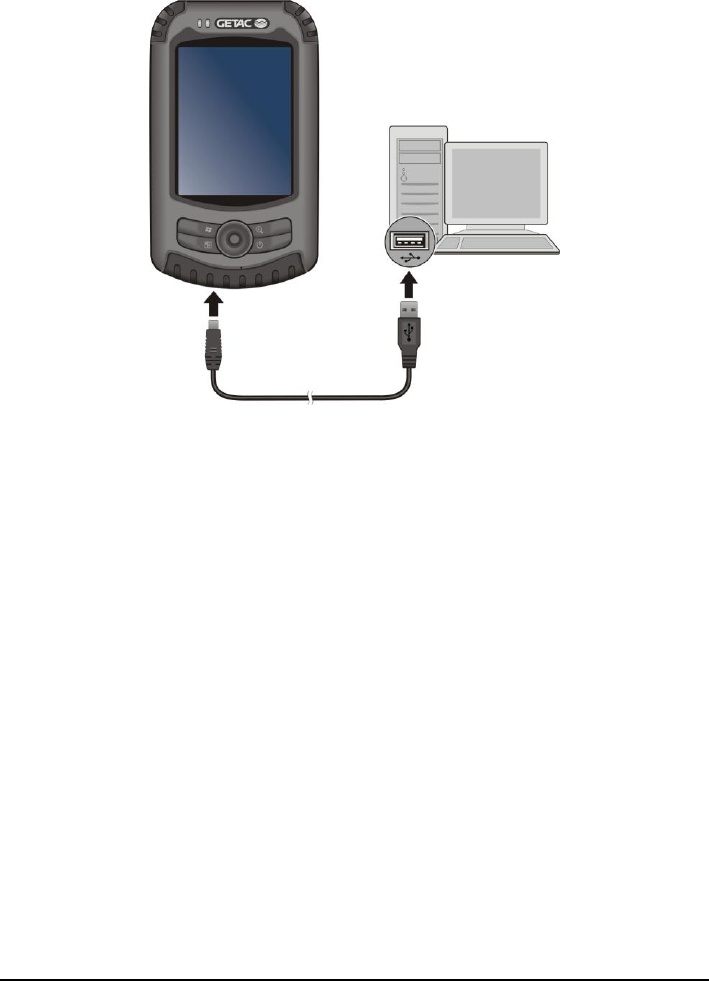
10
After the software installation, connect your device to your computer with the
USB cable and you are ready to synchronize.
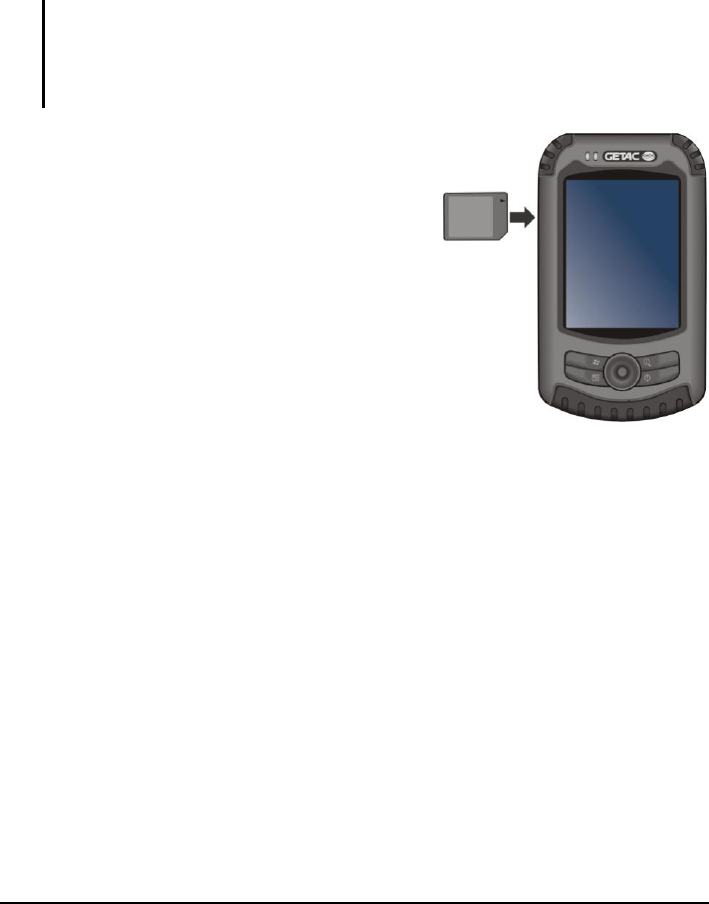
11
1.4 Using an SD/SDHC/MMC Card
Your Pocket PC has a SD/MMC slot where you can insert an optional Secure
Digital or MultiMediaCard storage card. With the removable memory, you can
store or backup your data and exchange data with other devices.
NOTE:
A storage card is also called a memory card.
Make sure that no foreign objects enter the slot.
Keep a SD or MMC card in a well-protected box to avoid dust and humidity when you are
not using it.
To use a card, insert it into the slot, with the
connector pointing to the slot and its label
facing the front of the Pocket PC. Follow the
instructions supplied with the card for more
information.
To remove a card, first make sure that no
application is accessing the card, then slightly
push the top edge of the card to release it and
pull it out of the slot.

12
2 Basic Skills
This chapter familiarizes you with the basic operations of your Pocket PC such
as using the stylus, navigation stick, Today screen, menus, and programs. You
will also know how to enter information and lock your Pocket PC.
2.1 Power Saving and Turning Off
Backlight Off
The backlight of the screen dims out after a period of inactivity (default 30
seconds while on battery power and 1 minute while on external power).
To restore the backlight, tap the screen or press a button. Note that where you tap
or what you press also causes the related task to be performed.
Entering the Suspend Mode
Your device automatically suspends after a period of inactivity (default 3
minutes while on battery power and 5 minutes while on external power).
To manually suspend the device, briefly press the power button.
To resume operation, press the power button. You will be back to where you left
off.
Turning Off
If you will not be using the device for a long time, you can turn off the device by
sliding the ON/OFF switch to the OFF position. To start using the device, slide
the switch to the ON position.
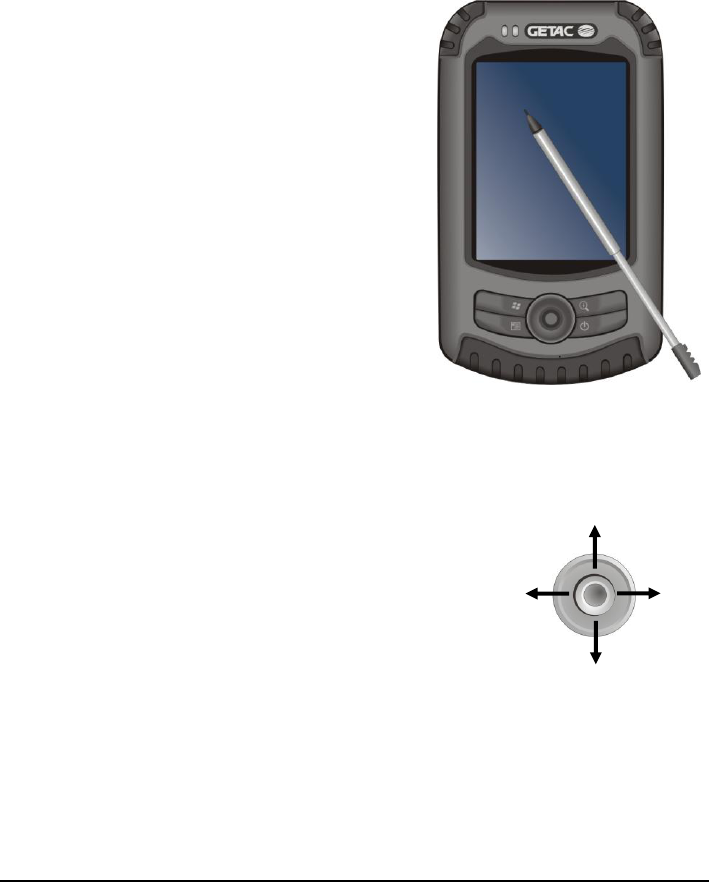
13
2.2 Using the Stylus
Use the stylus to navigate and select objects on the screen.
Pull the stylus out of the slot and extend it for ease of use. Store it in the slot
when not in use.
Tap
Touch the screen once with the stylus to
open items and select options.
Drag
Hold the stylus on the screen and drag
across the screen to select text and
images. Drag in a list to select multiple
items.
Tap and hold
Tap and hold the stylus on an item to see
a list of actions available for that item.
On the shortcut menu that appears, tap
the action you want to perform.
2.3 Using the Navigation Stick
With the navigation stick, you can move up, down, left
and right within a menu. This is particularly useful for
one-hand operation.
To move in a direction, simply push the stick toward
the corresponding direction.
To activate the selected item, press the stick.
Up
Left
Right
Down
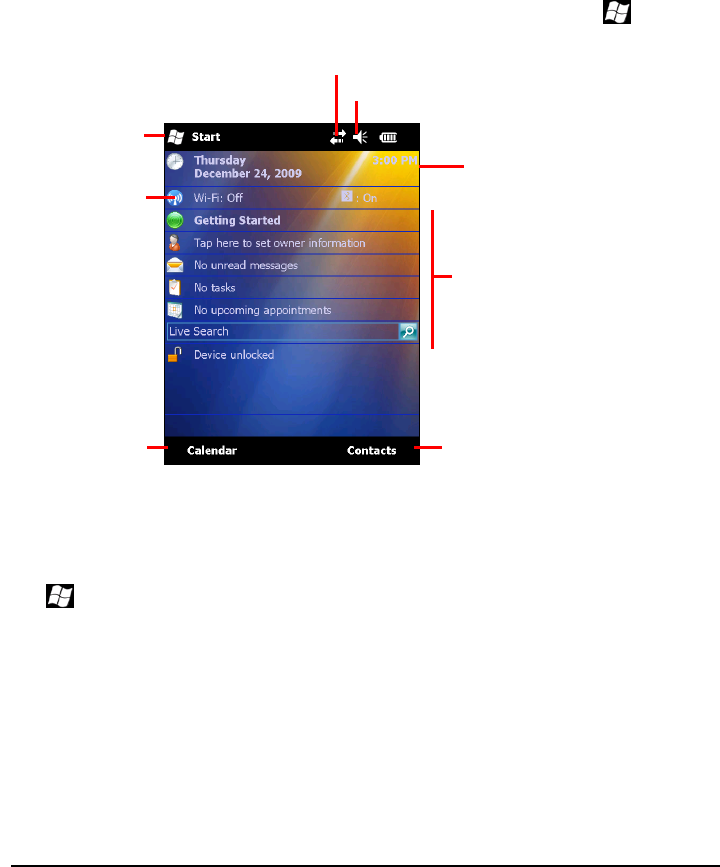
14
2.4 Today Screen
When you turn on your Pocket PC for the first time each day, you will see the
Today screen. The Today screen shows your upcoming appointments, active
tasks, and information about e-mail messages. Along the top of the Today screen
you will see the volume icon, the clock, and connectivity indicators. You can tap
a section of the Today screen to open the program that is associated with that
section. The Today screen is accessible from anywhere by tapping and then
Today.
Landscape View
You can use your Pocket PC in a landscape manner. To change the screen view,
tap Settings System Screen General Landscape or Portrait.
Tap to change date and time.
Tap to change volume or mute all sounds.
Tap to switch to a
program.
Left Soft Key
Right Soft Key
Tap to connect.
Your day at a glance.
Tap an item to access associated
program so that you can view or
change information.
Wireless network and
Bluetooth status
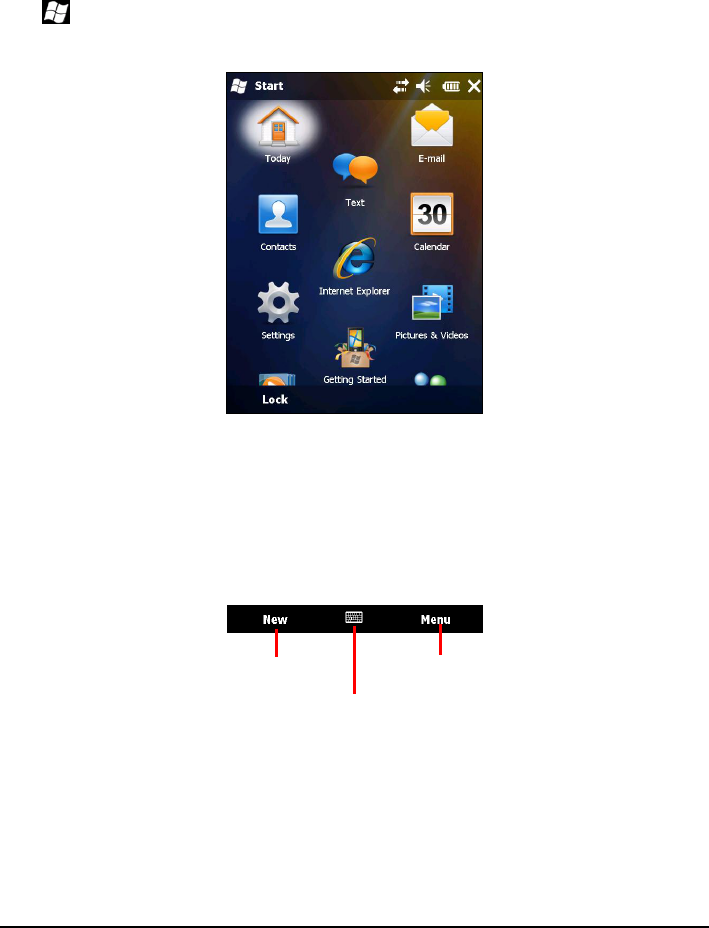
15
2.5 Navigation Bar and Toolbar
The Navigation bar is located at the top of the screen. It displays the active
program and current time and allows you to switch programs and close screens.
Tap to switch to the Start menu as shown below. The menu contains all the
program icons. You can drag the screen up or down to see other icons.
Use the toolbar at the bottom of the screen to perform tasks in programs. The
toolbar includes a left soft key, a right soft key, and the Input panel button in
between. The right soft key is usually Menu while the left soft key varies with
programs.
An example of the toolbar:
Left Soft Key
Right Soft Key
Input panel
button
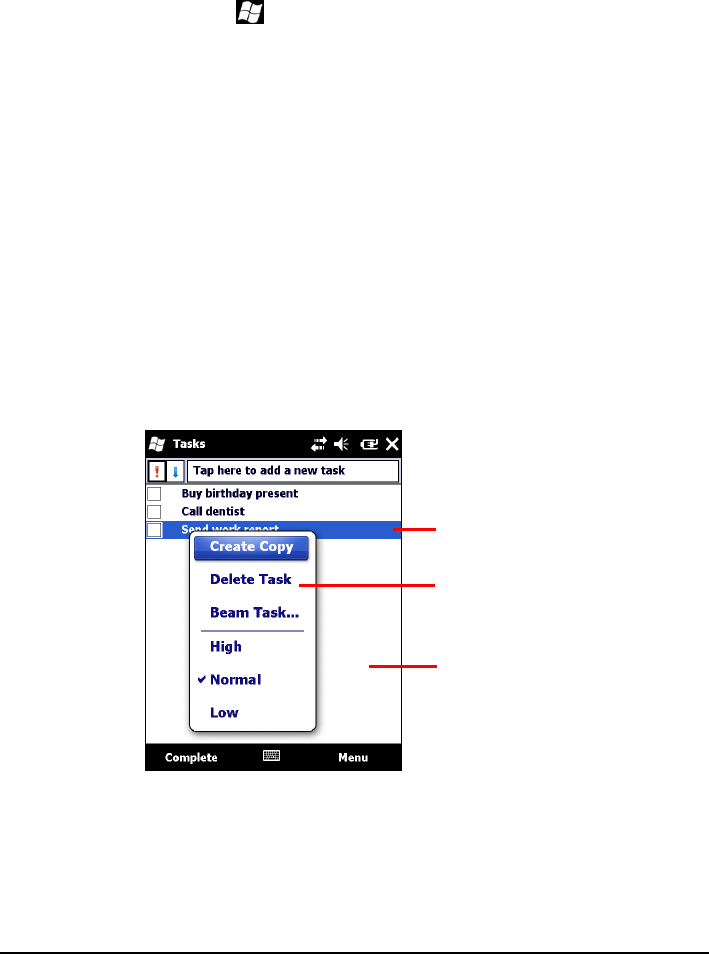
16
2.6 Running Programs
You can switch from one program to another without closing any program.
To run a program, tap at the left-top corner of the screen and select from
the Start menu.
You can press a program button on the front of your Pocket PC. The icons on
the buttons identify the default programs they are associated with.
2.7 Shortcut Menus
With shortcut menus, you can quickly choose an action for an item. For example,
you can use the shortcut menu in the contact list to quickly delete a contact, make
a copy of a contact or send an email message to a contact. The actions in the
shortcut menus vary from program to program. To access a shortcut menu, tap
and hold the stylus on the name of the item that you want to perform the action
on. When the menu appears, lift the stylus and tap the action you want to
perform. Or tap anywhere outside the menu to close the menu without
performing an action.
Tap and hold to display the
shortcut menu.
Lift the stylus and tap the action
you want.
Tap outside the menu to close it
without performing an action.

17
2.8 Notifications
Your Pocket PC reminds you in a variety of ways when you have something to
do. For example, if you have set up an appointment in Calendar, a task with a due
date in Tasks or an alarm in Clock, you will be notified in any of the following
ways:
A message appears on the screen.
A sound, which you can specify, is played.
The notification indicator flashes.
To choose reminder types and sounds for your Pocket PC, tap Settings
Personal Sounds & Notifications.
2.9 Entering Information
You have several options for entering new information:
Use the Input panel to enter typed text, either by using the soft keyboard or
other input methods.
Write directly on the screen.
Draw pictures on the screen.
Speak into the microphone to record a message.
Entering Text Using the Input Panel
Use the Input panel to enter information in any program on your Pocket PC. You
can either type using the soft keyboard or write using a recognizer. In any case,
the characters appear as typed text on the screen.
To show or hide the Input panel, tap the Input panel button. Tap the arrow next to
the Input panel button to see your choices.
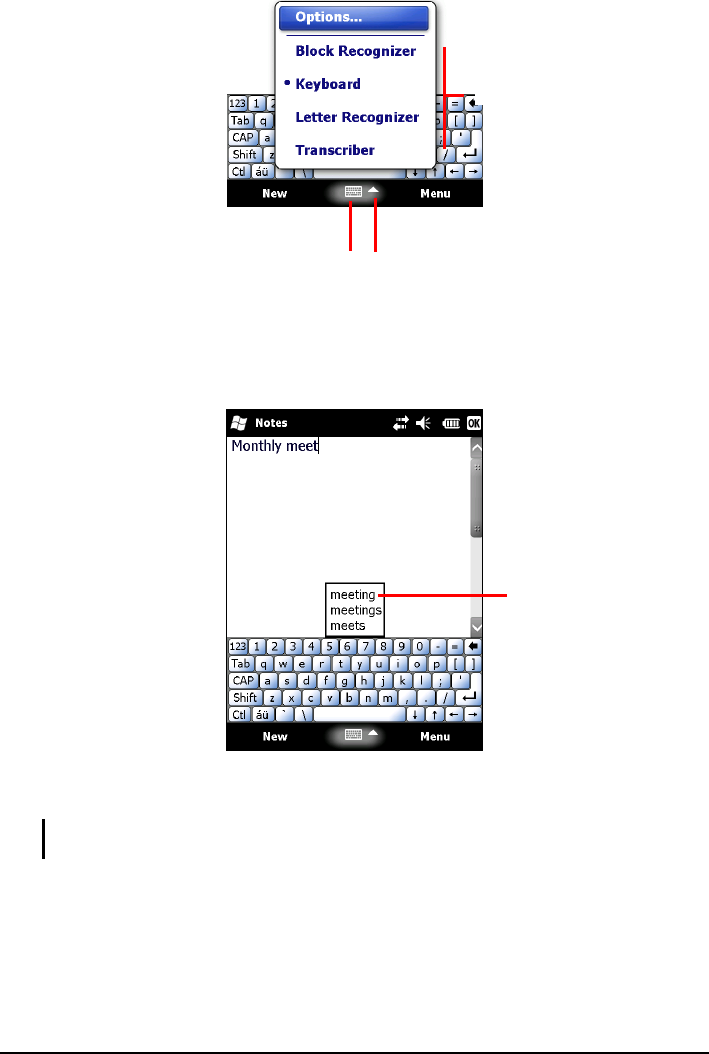
18
When you use the Input panel, your Pocket PC anticipates the word you are
typing or writing and displays it above the Input panel. When you tap the
displayed word, it is inserted into your text at the insertion point. The more you
use your Pocket PC, the more words it learns to anticipate.
Recognizer
NOTE: The availability of recognizers depends on the region and the language version you
purchased.
With a recognizer, you can write letters using the stylus just as you would use a
pen on paper.
When you write a letter, it is converted to typed text that appears on the screen.
For specific instructions on using a recognizer, open a recognizer and then tap
the question mark next to the writing area.
Select an input method.
Input panel button.
Tap to see your choices.
Tap here if this is
the right word.
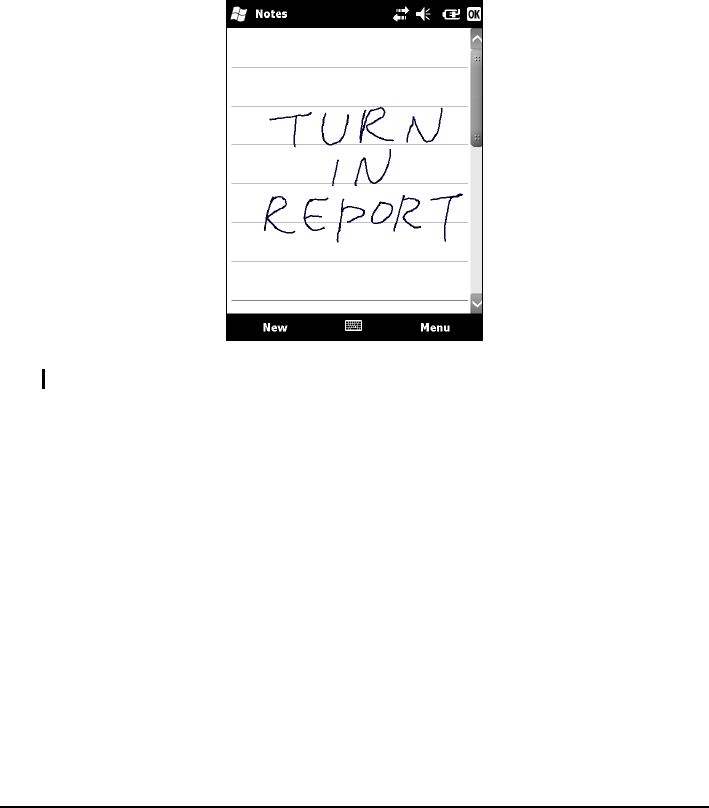
19
Writing on the Screen
In any program that accepts writing, such as the Notes program, you can use
your stylus to write directly on the screen. Write the way you do on paper. You
can edit and format what you have written and convert the information to text
later.
To write on the screen, tap Menu Draw to switch to drawing mode. A check ()
appears before the command.
NOTE: Not all programs support the drawing mode.
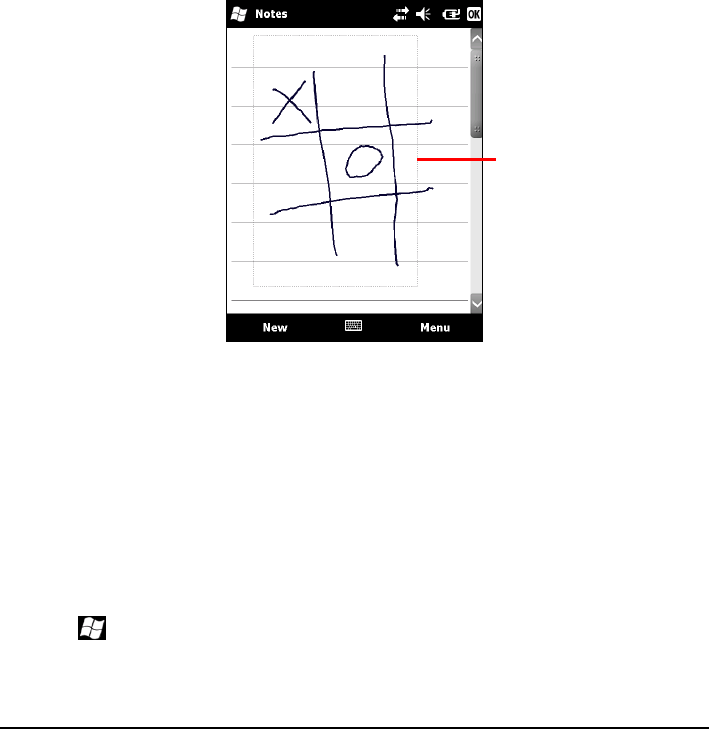
20
Drawing on the Screen
You can draw on the screen in the same way that you write on the screen.
1. Tap Menu Draw to enable drawing mode. A check () appears before the
command.
2. To create a drawing, cross three ruled lines on your first stroke. A drawing
box appears.
3. Subsequent strokes in or touching the drawing box become part of the
drawing. Drawings that do not cross three ruled lines will be treated as
writing.
Recording a Message
You can quickly capture thoughts, reminders and phone numbers by recording a
message. In the Notes program, you can either create a stand-alone recording or
include a recording in a written note. If you want to include the recording in a
note, open the note first. In the Messaging program, you can add a recording to
an email message.
To create a recording:
1. Tap Notes to switch to the program.
2. Tap Menu View Recording Toolbar to show the Recording toolbar.
The drawing box indicates
the boundaries of the
drawing.
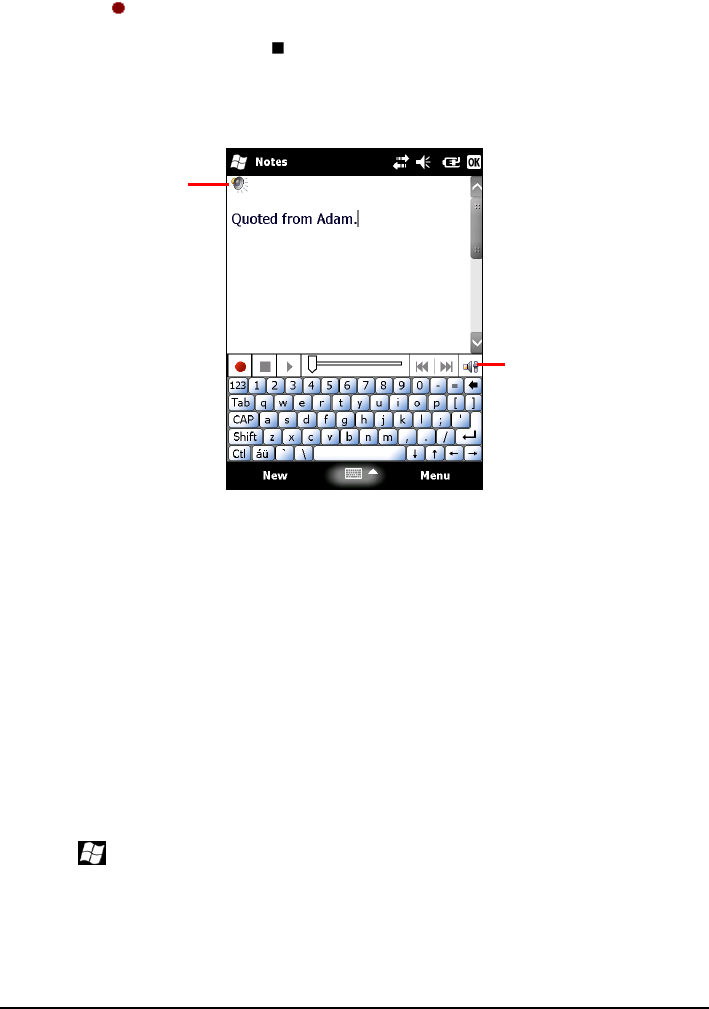
21
3. Hold the Pocket PC‘s microphone near your mouth or other source of sound.
4. Tap the Record button on the Recording toolbar to start recording.
5. To stop recording, tap the Stop button on the Recording toolbar. The new
recording appears in the note list or as an embedded icon.
To play a recording, tap it in the list or tap its icon in the note.
Recording Formats
Your Pocket PC supports several formats for voice notes. The formats vary in
both the quality of the recording and the size of the sound file. When selecting a
recording format, you should consider the quality you need as well as how much
storage memory the recording will use on your Pocket PC.
Not all recording formats are compatible with other software or computers. If
you will share your recordings with others or transfer a recording to your desktop
computer, be sure to choose a recording format that is supported by the software
used to play recordings on the other computer.
To select a recording format:
1. Tap Settings Personal Input.
2. On the Options tab in the Input control panel, select a voice recording format
from the drop-down list.
Indicates an
embedded recording.
Recording toolbar
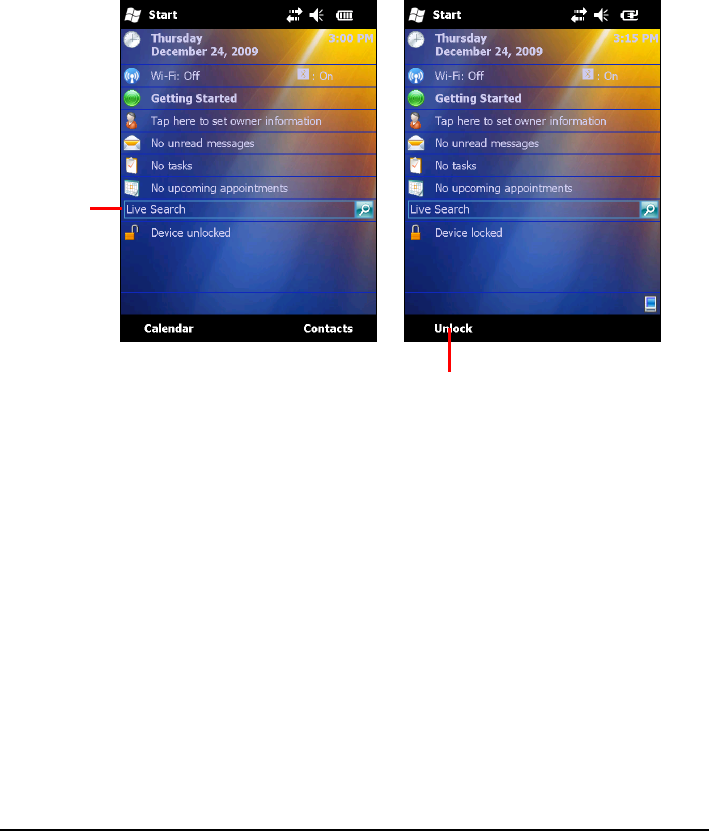
22
2.10 Locking Your Pocket PC
When not using your Pocket PC, you can use the lock function so that accidental
touching of the device does not cause your Pocket PC to operate.
To lock your Pocket PC, tap Device unlocked on the Today screen. Your Pocket
PC will not respond to any tapping of the screen (except the left soft key Unlock)
or pressing of the buttons (except the power button).
To unlock, tap Unlock (left soft key) and tap Unlock.
Tap to lock
the device.
Tap to unlock

23
3 Managing Your Pocket PC
This chapter tells you how to effectively manage power, settings, data and
programs of your Pocket PC.
3.1 Managing Power
A fully charged battery should provide power for up to 8 hours of use. The
operating time of a fully charged battery depends on how you are using the
Pocket PC. Some functions, such as using multimedia or operating a SD/MMC
card, may consume the battery power considerably.
Low Battery Signals and Actions
CAUTION: When you recharge the battery upon a warning of low power, you should
charge for at least 30 minutes. If you unplug the AC charger soon, you may not have
sufficient battery power for your operation.
You can monitor the battery power by tapping Settings System Power.
The remaining power is displayed on a status bar in the Power control panel.
When the battery is low, your Pocket PC will pop up a warning message and a
beep will sound. You should save your data and recharge the battery
immediately upon a warning of low power; otherwise your Pocket PC will turn
off automatically. You need to connect the Pocket PC to external AC power for
charging before you can use it again.

24
Power-Saving Tips
Follow these suggestions to maximize the battery‘s operating time, particularly
when you are relying solely on the battery power for extended time periods.
Suspend frequently.
By default, the screen backlight will automatically turn off and the Pocket
PC will also turn off when it has been idle for a period of time. You can
shorten the length of the idle time using Settings System Power
Advanced to set up.
Press the power button to turn off your Pocket PC when it is not in use, even
for a short time. You can also manually turn off the backlight by pressing
and holding the power button.
Turn off functions not needed or adjust settings.
Lower the volume.
Do not enable sounds or light flashing except for the most necessary
notifications. (Tap Settings Personal Sounds & Notifications to
set up.)
Avoid power-consuming situations such as:
Using a modem or other peripheral
Playing sound or music
Recording
Using or monitoring wireless signals
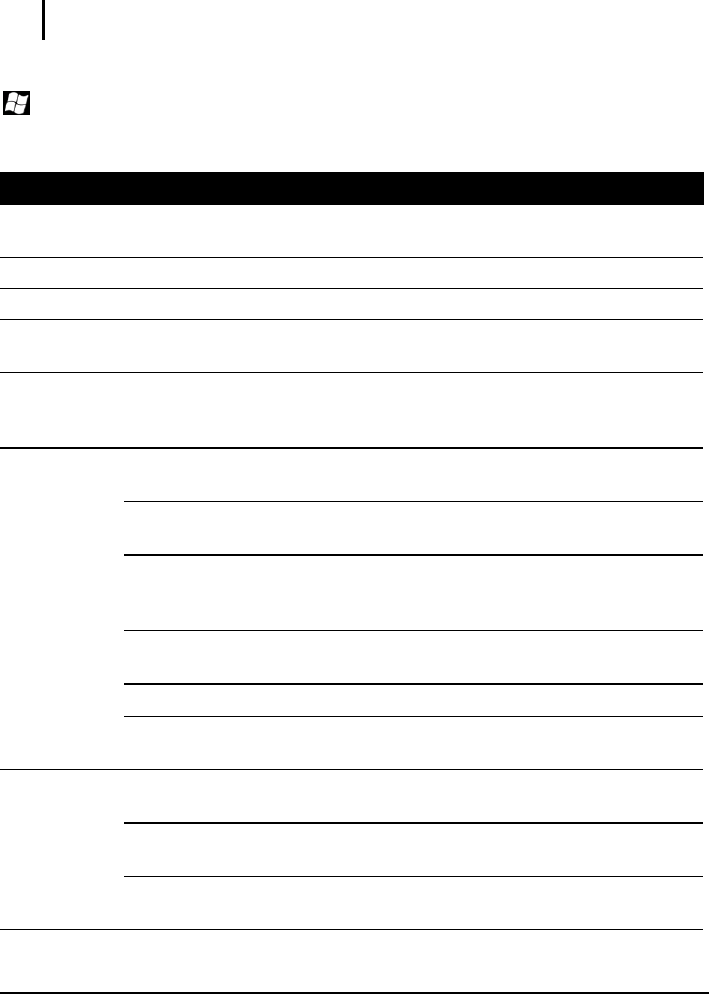
25
3.2 Customizing Your Pocket PC
NOTE: Incorrect settings may cause your system to malfunction. Make sure that you fully
understand the function of a certain item before any adjustment.
You can customize the settings of the Pocket PC to your own preferences. Tap
Settings.
The items you can customize are described as follows:
Items
Descriptions
Bluetooth
To set up or change the Bluetooth connection. (See
Section 6.2 for more information.)
Clock & Alarms
To change the time and date and to set alarms.
Lock
To set a password for security.
Sounds & Notifications
To set the conditions and types of the sounds, system
volume and ways of notifications.
Today
To select the information you want displayed on the
Today screen and to select a desired theme for the
background.
Connections
Beam
To receive information and files via Bluetooth
technology.
Connections
To set up or change connection information. (See
Section 6.1 for more information.)
Domain
Enroll
To connect your device with company resources. You
will need the enrollment password provided by your
system administrator.
USB to PC
To change the type of USB connection your device is
using and to enable advanced network functionality.
Wi-Fi
To configure the wireless network module.
Wireless
Manager
To change the Wi-Fi and Bluetooth radio status. (See
Section 6.1 and 6.2 for more information.)
Personal
Buttons
To assigns programs to the hardware buttons and set
the repeat rate of the up/down control.
Input
To set up items related to the input methods and voice
recording format.
Owner
Information
To enter your personal information.

26
Items
Descriptions
System
About
To show the hardware information of the Pocket PC
and to define the device name for identifying itself to
other computers.
Backlight
To adjust the brightness level of the display and to set
the automatic turnoff for power saving purposes.
Certificates
To establish your identity or the identity of other
computers. This helps prevent unauthorized users
from accessing your Pocket PC and information.
Customer
Feedback
To feedback to Microsoft of your experience in using
the Windows Mobile software.
Encryption
To encrypt files when they are placed on a storage card.
Error
Reporting
To enable or disable error reporting to Windows Mobile
technical support group.
External
GPS
To configure the GPS hardware settings and manage
GPS.
Managed
Programs
To show the installation history of managed programs.
Memory
To view the system memory or the memory on the
storage card (if installed) and to manually stop a program
if it becomes unstable or program memory is low.
Power
To show the remaining battery power and to set the
time for the Pocket PC to turn off automatically.
Regional
Settings
To specify the region of your location and the formats
of the number, currency, time and date.
Remove
Programs
To remove programs you added to the RAM of your
Pocket PC.
SBAS Setting
To enable SBAS (WAAS, MSAS, ENGOS) function.
A SBAS-capable receiver can give you a better
position accuracy.
Screen
To set the orientation of the screen to portrait or
landscape.
To adjust the touch screen for accurate screen taps.
To adjust the text size to see more content or increase
the readability in many programs.
System
Information
To view system information.

27
Items
Descriptions
Task
Manager
To view or perform task management of programs.
3.3 Searching and Organizing Information
The Search feature on your Pocket PC helps you quickly locate information.
To search a file, tap Search Phone. Enter the text you want to find, select a
data type and then tap Search to start the search.
You can also use the File Explorer to find files on your Pocket PC and to
organize these files into folders. Tap File Explorer.
NOTE: You can move files in File Explorer by tapping and holding the item you want to
move, tapping Cut or Copy on the shortcut menu, browsing to the new location and then
tapping Paste.
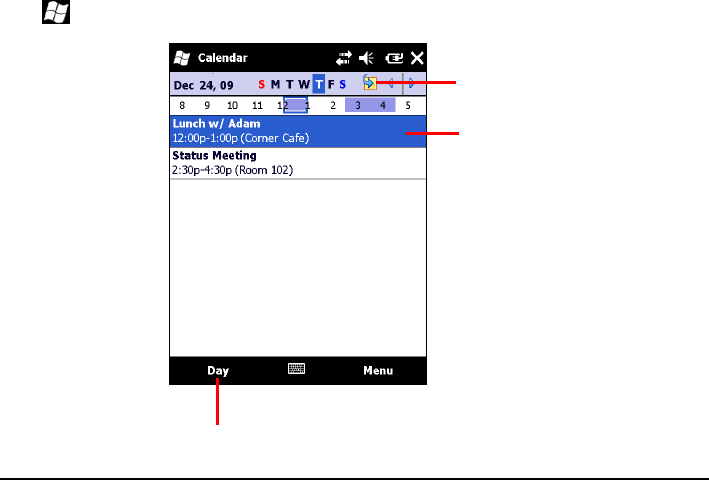
28
4 Microsoft Pocket Outlook
Microsoft Pocket Outlook includes Calendar, Contacts, Tasks, Notes, and
Messaging. You can use these programs individually or together. For example,
e-mail addresses stored in Contacts can be used to address e-mail messages in
Messaging.
4.1 Calendar: Scheduling Appointments and
Meetings
Use Calendar to schedule appointments, including meetings and other events. You
can check your appointments in one of several views (Agenda, Day, Week, Month
and Year) and set Calendar to remind you of appointments with a sound or other
method. Appointments for the day can be displayed on the Today screen.
Tap Calendar to switch to the program.
Tap to go to today.
Tap to display or edit the
appointment details.
Tap to switch to another view.
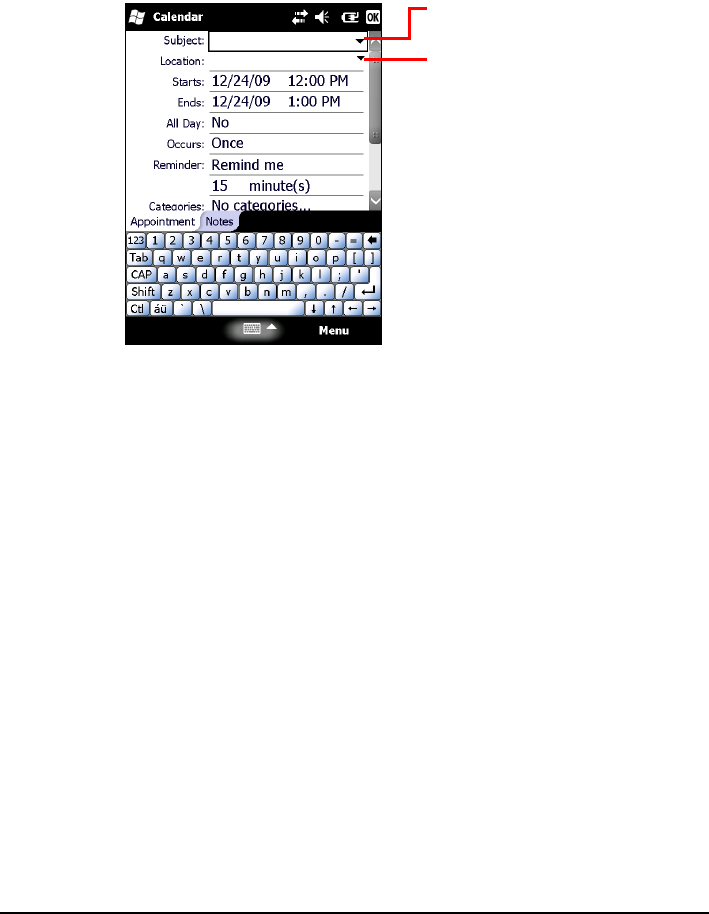
29
Creating an Appointment
1. In Day or Week view, tap the desired date and time for the appointment.
2. Tap Menu New Appointment.
3. Using the Input panel, tap first to select the field, and then enter a description
and a location.
4. If needed, tap the date and time to change them.
5. Enter other desired information. You will need to hide the Input panel to see
all available fields.
6. Tap OK to save and return to Calendar.
Tap to choose from predefined text.
Tap to choose from previously entered
locations.
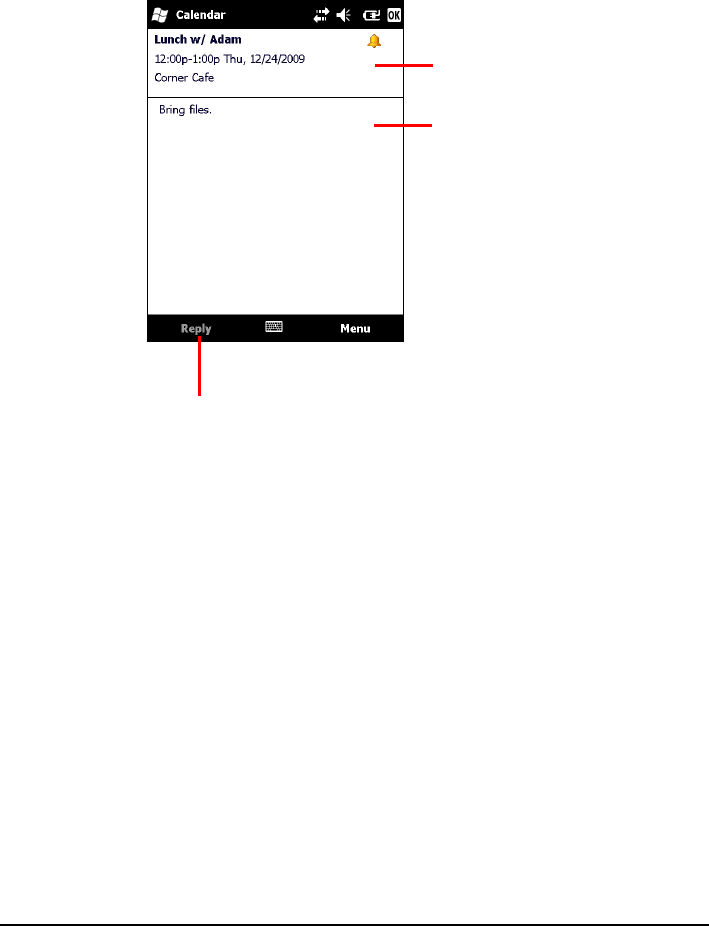
30
Using the Calendar Summary Screen
When you tap an appointment in Calendar, a summary screen is displayed. To
change the appointment, tap Menu Edit.
View appointment details.
View notes.
Tap to send e-mail to the
attendees if they are added to
your appointment.
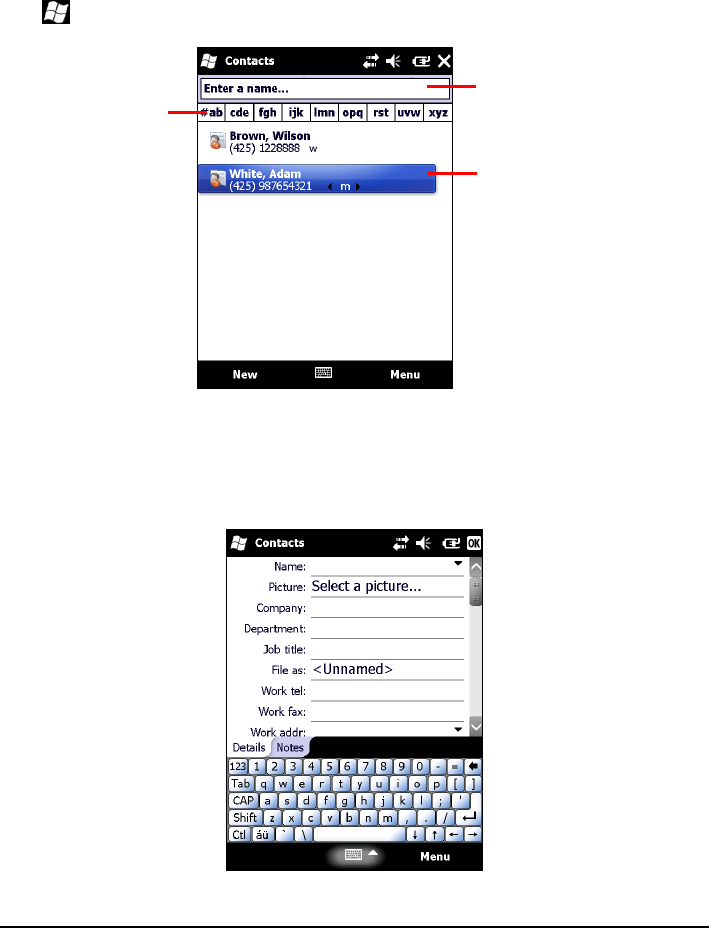
31
4.2 Contacts: Tracking Friends and Colleagues
Contacts maintains a list of your friends and colleagues so that you can easily
find the information you are looking for, whether you are at home or on the road.
Tap Contacts to switch to the program.
Creating a Contact
1. In Contacts, tap New.
Tap and enter part of a name or
number to quickly find a contact
in the list.
Tap to display or edit the contact
details.
Tap an alphabet group
to scroll the contact list.
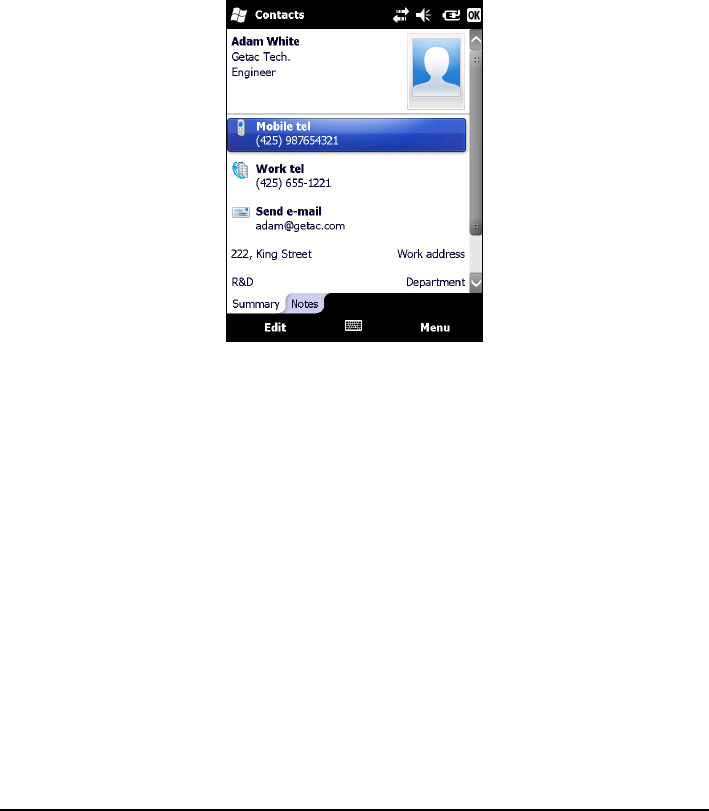
32
2. Using the Input panel, enter a name and other contact information. You will
need to scroll down to see all available fields.
3. Tap OK to save and return to the contact list.
Using the Contacts Summary Screen
When you tap a contact in the contact list, a summary screen is displayed. To
change the contact information, tap Edit.
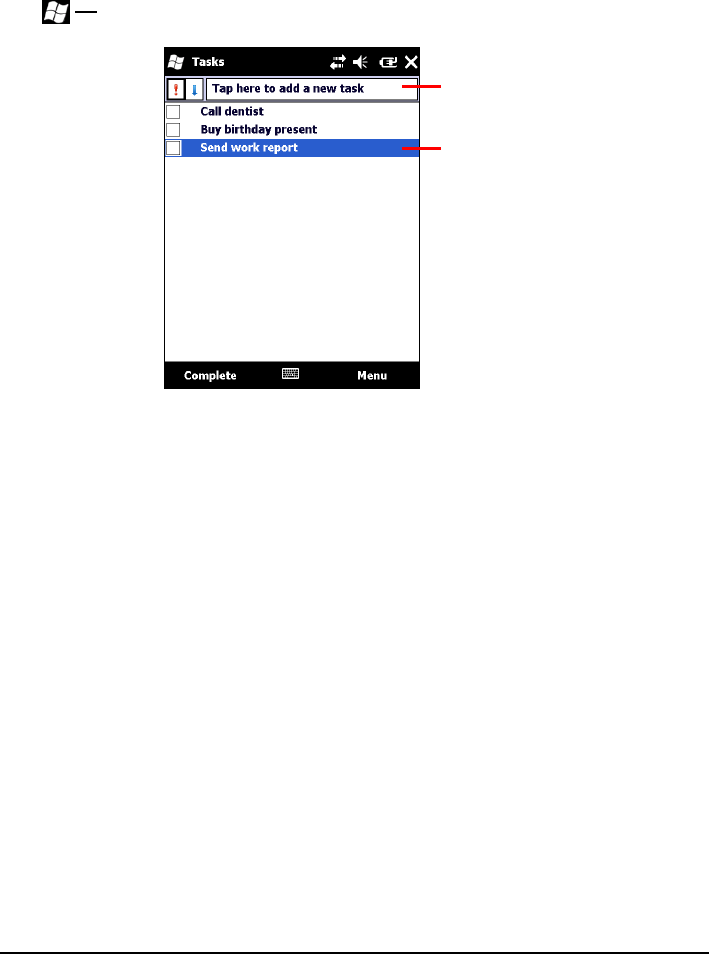
33
4.3 Tasks: Keeping a To Do List
Use Tasks to keep track of what you have to do.
Tap Tasks to switch to the program.
Tap to quickly create a task with
only a subject
Tap to display or edit the task
details.
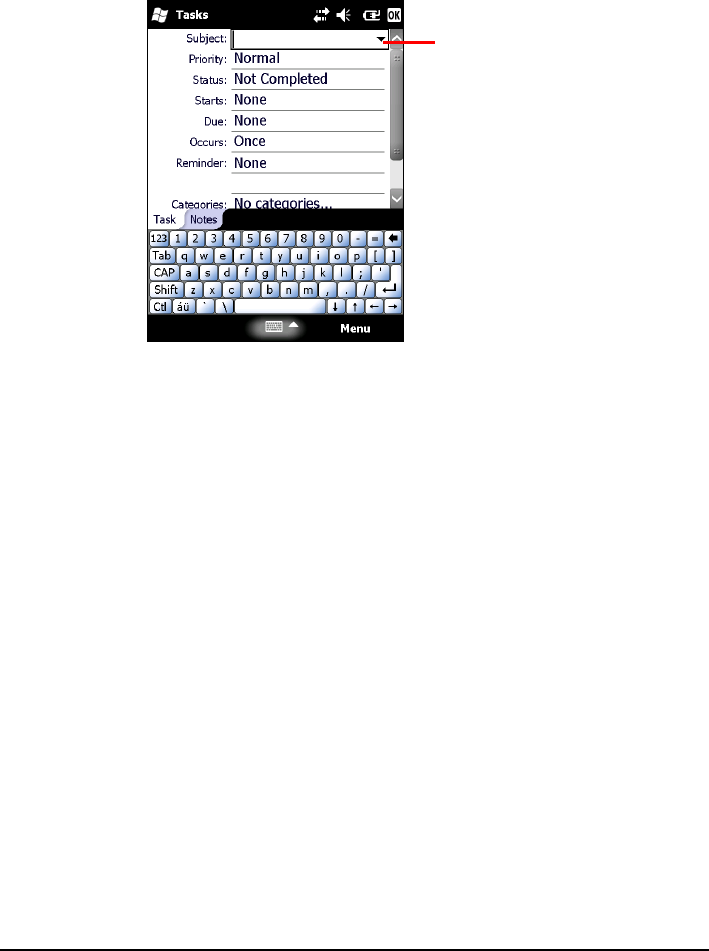
34
Creating a Task
1. In Task, tap Menu New Task.
2. Using the Input panel, enter a description.
3. You can enter a start date and due date or enter other information by first
tapping the field. If the Input panel is open, you will need to hide it to see all
available fields.
4. Tap OK to save and return to the task list.
Tap to choose from predefined
subjects.
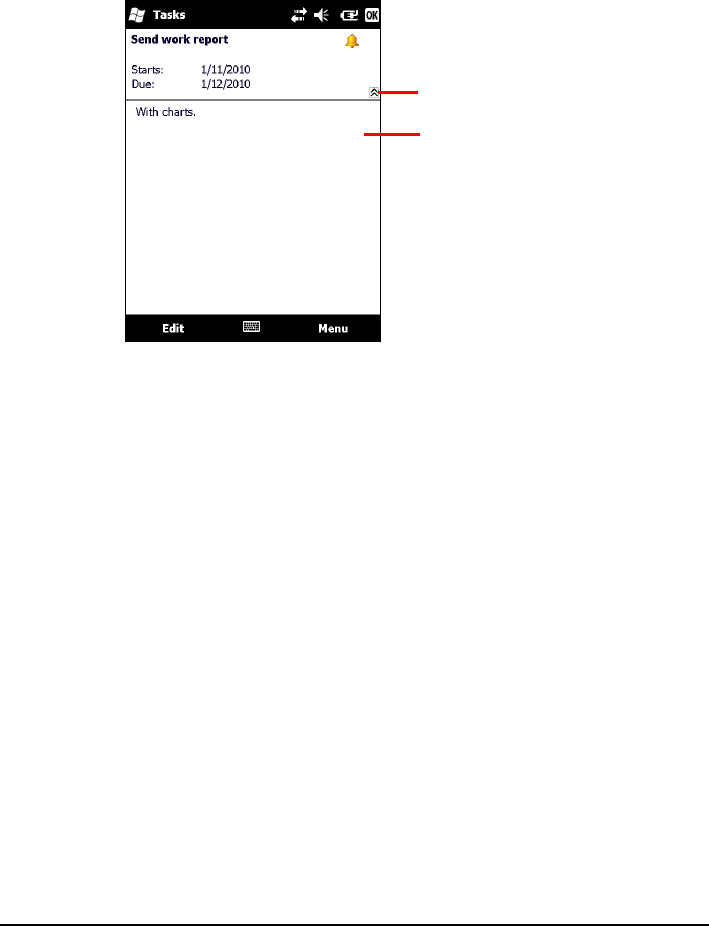
35
Using the Tasks Summary Screen
When you tap a task in the task list, a summary screen is displayed. To change
the task, tap Edit.
Tap to show and hide additional
summary information.
View notes.
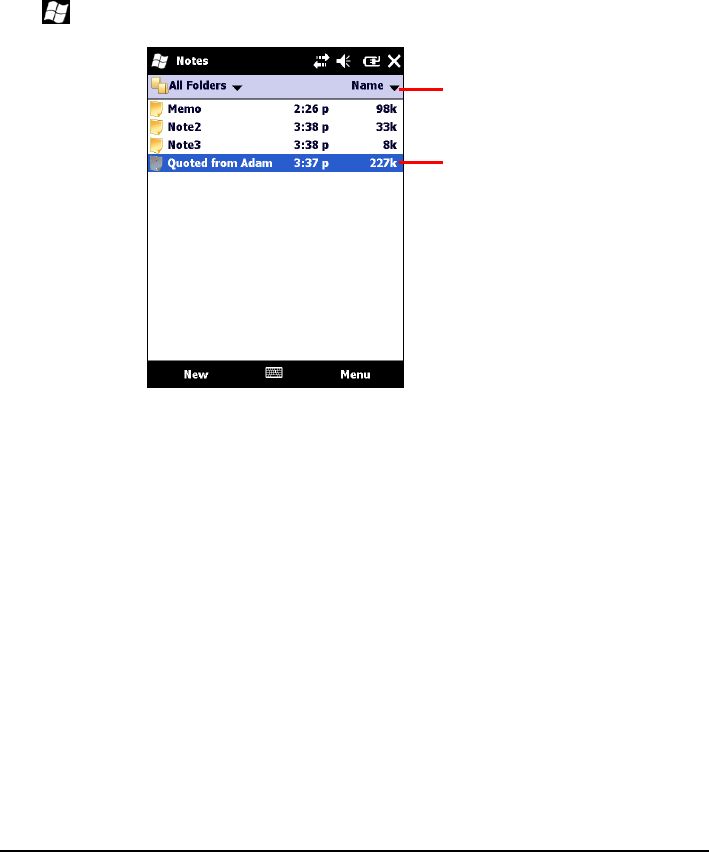
36
4.4 Notes: Capturing Thoughts and Ideas
Quickly capture thoughts, reminders, ideas, drawings and phone numbers with
Notes. You can create a written note or a recording. You can also include a
recording in a note. If a note is open when you create the recording, it will be
included in the note as an icon. If the note list is displayed, it will be created as a
stand-alone recording.
Tap Notes to switch to the program.
Tap to change the sort order of
the list.
Tap to open a note or play a
recording.
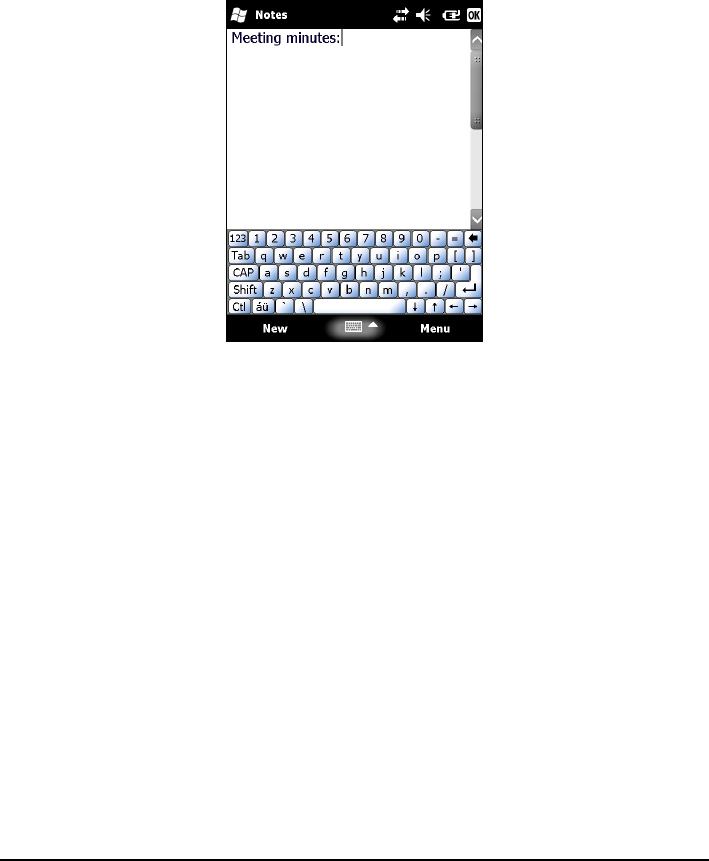
37
Creating a Note
1. In Notes, tap New.
2. Create your note by writing, drawing, typing, or recording. For more
information about using the Input panel, writing, and drawing on the screen
and creating recordings, see Section 2.8.
3. Tap OK to save and return to the note list.

38
4.5 E-mail: Sending and Receiving E-mail Messages
You can use E-mail to send and receive email messages in two ways:
By synchronizing email messages with Microsoft Exchange or Microsoft
Outlook on your desktop computer.
By connecting directly to an e-mail server through an ISP (Internet Service
Provider) or a network.
Tap E-mail to switch to the program.
Synchronizing E-mail Messages
E-mail messages can be synchronized as part of the general synchronization
process. To do this, you need to enable Inbox synchronization in
ActiveSync/Mobile Device Center. For information on enabling Inbox
synchronization, see ActiveSync Help on the desktop computer.
Connecting Directly to an E-mail Server
You can send and receive email messages by connecting to a POP3 or IMAP4
e-mail server if you can connect to your ISP or local area network. (For
information on connection, see Section 6.1.)
Setting up an Email Service
You can use multiple email services to receive your messages. For each email
service you intend to use, first set up and name the email service.
Tap Setup E-mail. Follow the directions in the E-mail Setup Wizard.
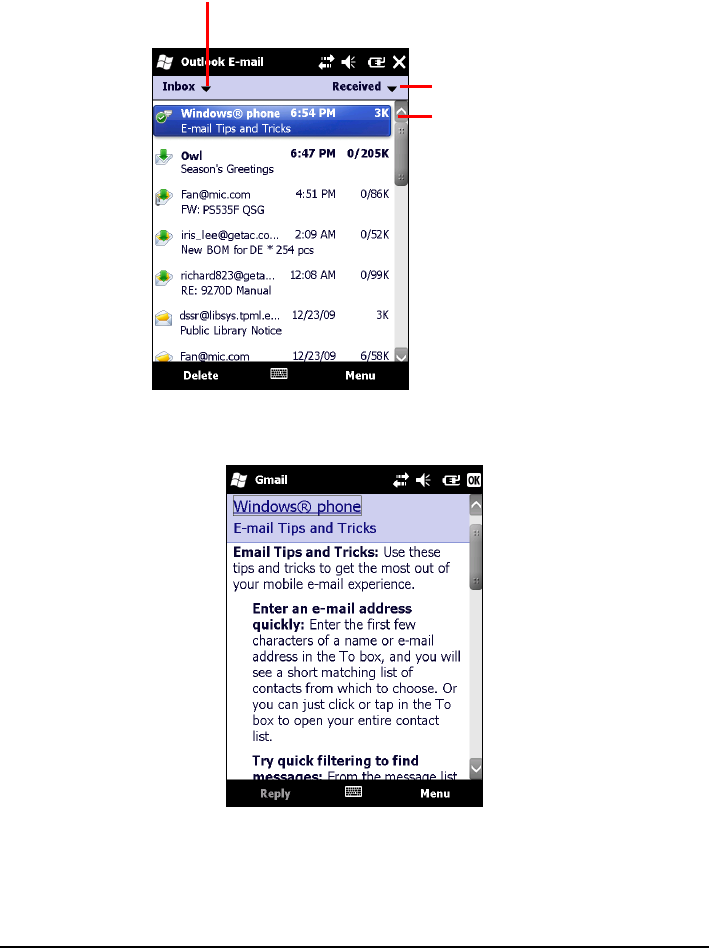
39
Using the Message List
Messages you receive are displayed in the message list.
When you receive a message, tap it to open it.
Select the sort order for messages.
Tap to open a message.
Select the service and folder
you want to display.
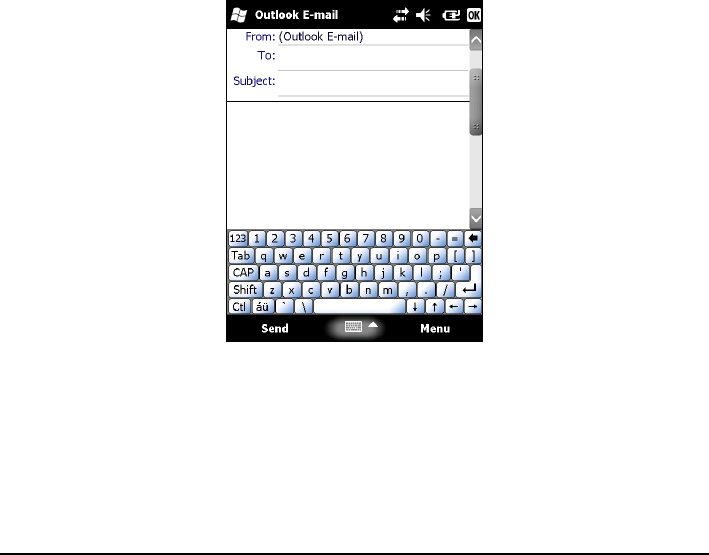
40
When you connect to your email server or synchronize with your desktop
computer or server, by default, you will receive messages from the last three
days only and the first 2 KB of each new message, and not to sync file
attachments. The original messages remain on the server or your desktop
computer.
You can mark the messages that you want to retrieve in full during your next
synchronization or email server connection. In the message list, tap and hold the
message you want to retrieve. On the shortcut menu, tap Download Message. The
icons in the Inbox message list give you visual indications of message status.
Composing and Sending Messages
1. Select the account you have set in E-mail.
2. In the message list, tap Menu New.
3. In the To field, enter an email address of one or more recipients, separating
them with a semicolon. If the address is already in your contact list, you can
tap To to select the e-mail address.
4. Enter your message.
5. To check spelling, tap Menu Spell Check.
6. If you want to attach a file to the message, tap Menu Insert and select the
desired file.

41
NOTE: OLE objects cannot be attached to Inbox messages.
7. Tap Send when you have finished the message. If you are working offline,
the message is moved to the Outbox folder and is sent the next time you
connect.
The message is placed in the Outbox folder on your Pocket PC and will be
delivered in one of two ways:
The message is transferred to the Outbox folder in Exchange or Outlook on
your desktop computer and sent the next time you synchronize.
The message is transferred to your email server the next time you connect.
Managing Email Messages and Folders
Each e-mail service account has its own folder hierarchy with five default
folders: Inbox, Outbox, Deleted Items, Drafts and Sent Items. The messages you
receive and send through the mail service are stored in these folders. You can
also create additional folders within each hierarchy. To create folders, tap Menu
Tools Manage Folders.
The Deleted Items folder contains messages that have been deleted on your
Pocket PC. The behaviour of the Deleted and Sent Items folders depends on the
options you have chosen.
NOTE: If you use POP3 and you move email messages to a folder you created, the link is
broken between the messages on the Pocket PC and their copies on the mail server. The
next time you connect, the mail server sees that the messages are missing from the Pocket
PC Inbox and deletes them from the server.

42
5 More Programs
In addition to Microsoft Pocket Outlook, there are other programs built into your
Pocket PC. This chapter tells you how to use these programs.
NOTE: Depending on the continuing developments of the product, the software supplied
with the device may be changed or updated. If there is any difference between the
information in this manual and your product, the operation should be based on the product
you have.
5.1 Microsoft ActiveSync
ActiveSync on your device works with ActiveSync on a Windows XP computer
and with Windows Mobile Device Center on a Windows Vista/Windows 7
computer.
When you have established the connection between your device and your
computer, you can synchronize the information between the two with
ActiveSync. Synchronization compares the data on the two sides and updates
both computers with the most recent information. For example, you can:
Keep your Pocket Outlook Contacts, Calendar and Tasks databases
up-to-date by synchronizing your Pocket PC with Microsoft Outlook data on
your desktop computer.
Synchronize email messages in your Pocket PC Inbox with email messages
in Microsoft Outlook on your desktop computer.
Synchronize Microsoft Word, Excel, and PowerPoint files between your
Pocket PC and desktop computer. Your files are automatically converted to
the correct format.
You can select which information types are synchronized and control how much
data is synchronized. (See the ActiveSync or Windows Mobile Device Center
help on your computer.)
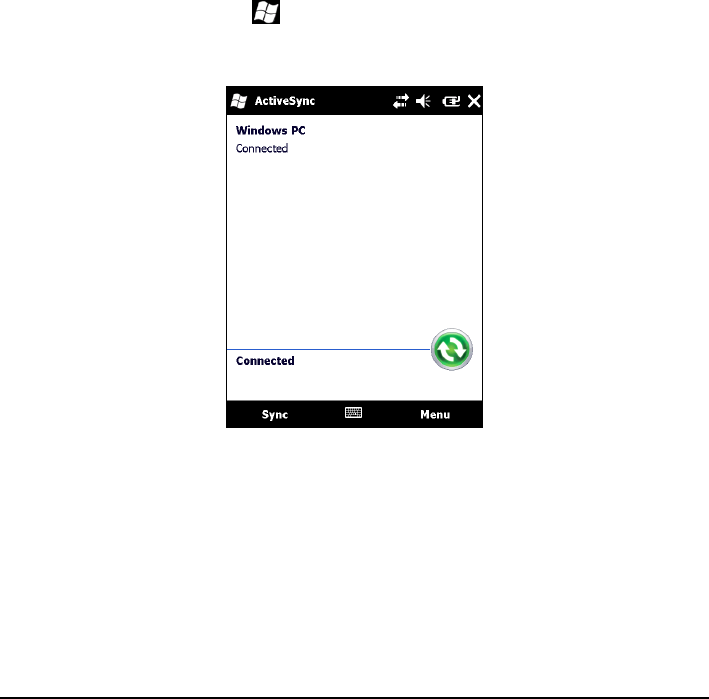
43
With ActiveSync, you can also:
Copy (rather than synchronize) files between your Pocket PC and desktop
computer.
Add and remove programs on your Pocket PC.
Pass through your desktop computer to a network or the Internet.
Synchronizing Data
Once you have created a synchronization relationship and completed the first
synchronization, you can initiate synchronization from your Pocket PC.
1. Connect your Pocket PC to your desktop computer.
2. On your Pocket PC, tap ActiveSync.
3. Tap Sync to begin synchronization.
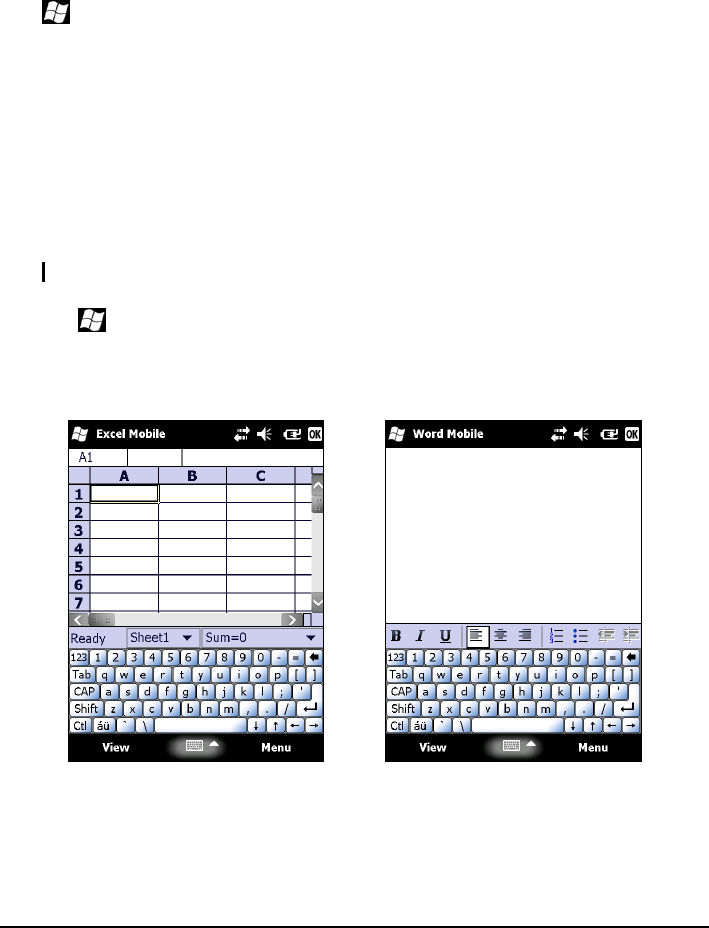
44
5.2 Office Mobile
Microsoft Office Mobile works with Microsoft Office on your computer to give
you easy access to copies of your Office files.
Tap Office Mobile and select the program to use.
Excel Mobile
OneNote Mobile
PowerPoint Mobile
Word Mobile
Creating an Office File
NOTE: You cannot create or edit PowerPoint presentations on your device.
1. Tap Office Mobile and select the program to use.
2. Enter the information. (For more information on using the input panel, see
Section 2.8 or Pocket PC Help.)
Excel Mobile Word Mobile

45
OneNote Mobile
3. When you have finished entering the information and tap OK, the file is
automatically saved and named according to the first characters of text
entered in the file.
Opening an Office File
Whenever you switch to an Office Mobile program, you will see the file list. Tap
the desired file to open it. You can open only one file at a time; when you open a
second file, the first will be saved and closed automatically.

46
5.3 Windows Live Messenger
Windows Live Messenger provides practically instant access to your up-to-date
MSN Hotmail Inbox, your Messenger Contacts list, and options for customizing
your Messenger experience.
With Windows Live Messenger, you get:
MSN Hotmail
Read, write and send e-mail. Delete e-mail and manage your Hotmail
folders.
MSN Messenger
See who is online. Send and receive instant messages. Subscribe to status
updates for selected contacts so you are notified when they are online.
Synchronize the Windows Live contacts, Hotmail inbox and MSN
Messenger to your device.
You need to connect to the internet before using Windows Live. (For more
information on the connection, see Chapter 6.)
NOTE: Leaving Windows Live active for a long period of time will consume more power.
To use Windows Live, you need to create a MSN Hotmail, MSN Messenger or
Windows Passport account.
Setting up Windows Live
1. Tap Windows Live to switch to the program.
2. Tap Sign in to Windows Live.
3. Tap Accept to proceed.
4. Follow the on-screen instructions to complete the setup.
Signing in to Messenger
Before you sign in to Messenger, you need to sign in to Windows Live first.
1. Tap Messenger to switch to the program.
2. Tap Sign in.
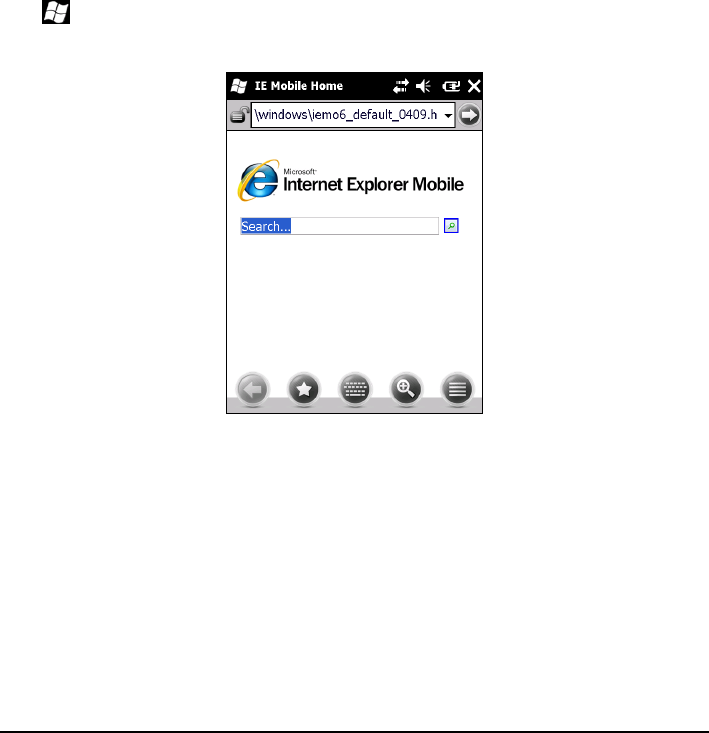
47
5.4 Using Internet Explorer Mobile
Use Internet Explorer Mobile to view Web pages in either of these ways:
Connect to an ISP or network and browse the Web. To do this, you will need
to create the connection first, as described in Section 6.1 and 6.2.
During synchronization with your desktop computer, download your
favorite links and mobile favorites that are stored in the Mobile Favorites
subfolder in Internet Explorer on the desktop computer.
While you are connected to an ISP or network, you can also download files and
programs from the Internet or an intranet.
Tap Internet Explorer to switch to the program. The Internet Explorer
Mobile home page appears:
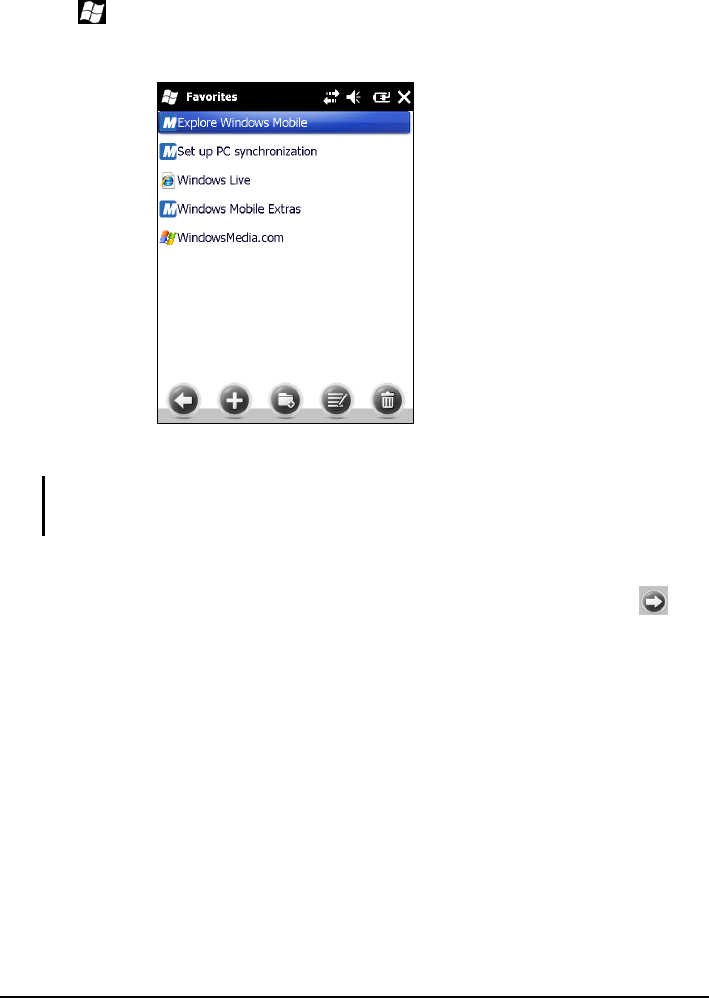
48
Browsing the Internet
1. Tap Internet Explorer.
2. Tap the Favorites soft key to display the Favorites list.
3. Tap the page that you want to view.
NOTE: If a favorite link is dimmed or you receive a message that the page is not available,
you must download the page to your device through synchronization or connect to the
Internet.
To visit web pages not included in Favorites, in the address bar that appears at
the top of the screen, enter the web address you want to visit and then tap . Or,
tap the arrow to choose from previously entered addresses.
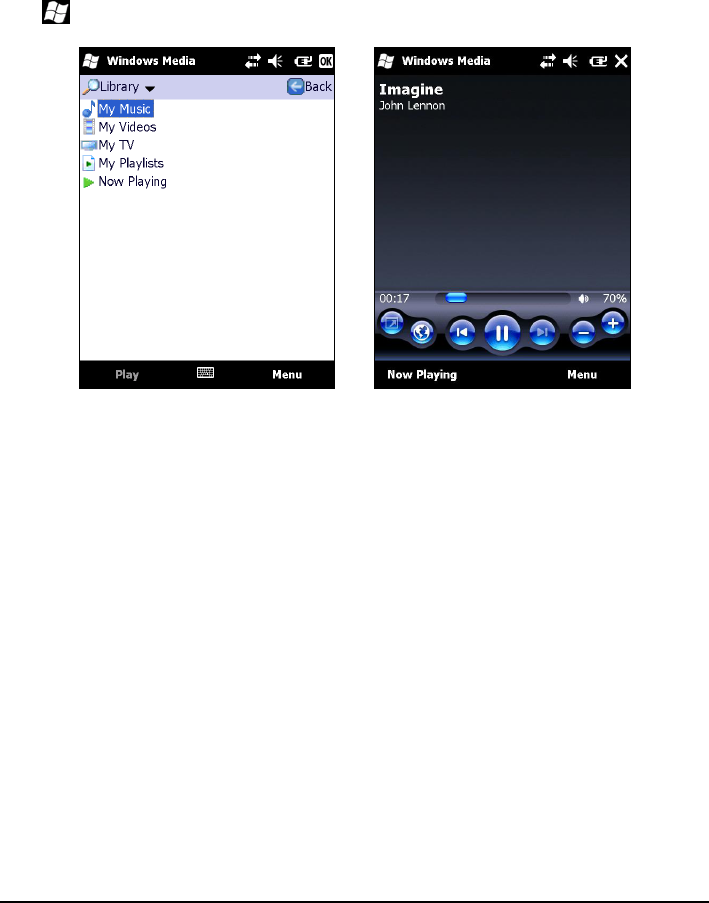
49
5.5 Windows Media Player for Pocket PC
Use Microsoft Windows Media Player for Pocket PC to play digital audio and
video files that are stored on your Pocket PC or on a network, such as on a Web
site.
Tap Windows Media to switch to the program.
Library Screen Playback Screen
You can play files in either Windows Media or MP3 format (this include files
with the extension.asf, .wma, .wmv and.mp3).
Use Microsoft Windows Media Player on your desktop computer to copy digital
audio and video files to your Pocket PC.
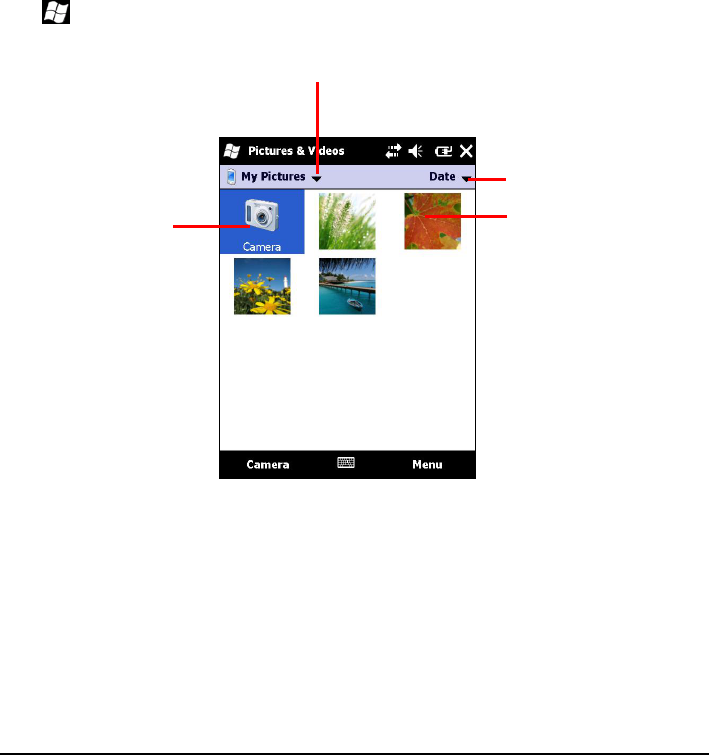
50
5.6 Pictures & Videos
With Pictures & Videos, you can:
View pictures and video clips.
Send pictures and videos to others.
Set a picture as the background on the Today screen.
Play slide show.
Edit your pictures.
Tap Pictures & Videos to switch to the program.
Select the type of folder you
want displayed in the list.
Tap to change the sort
order of the list.
Tap to view a picture in full
screen.
Tap to take pictures using
the camera lens located on
the back of the Pocket PC.
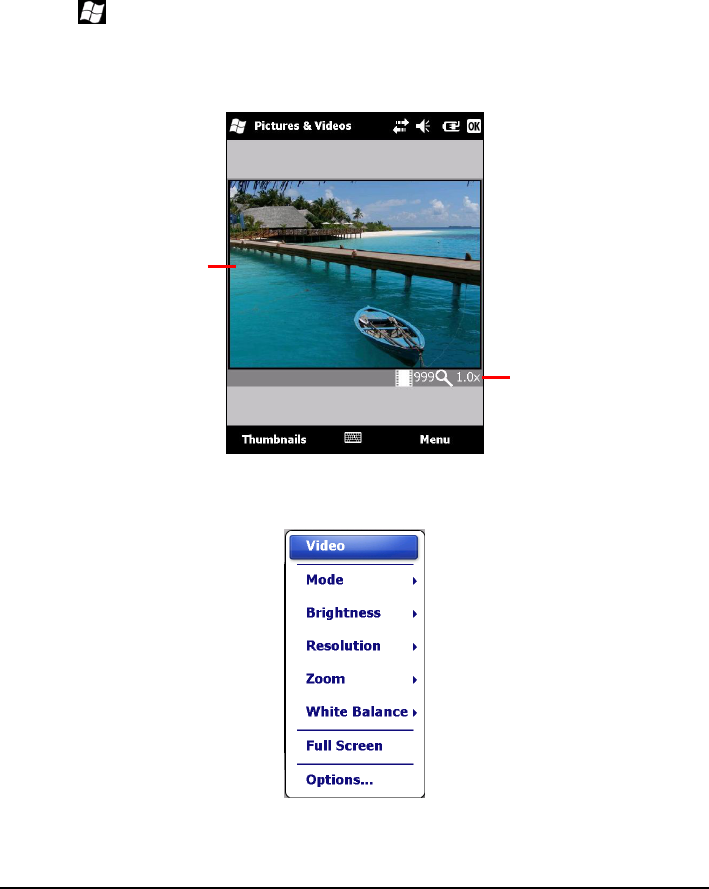
51
5.7 Camera
The Camera program allows you to take pictures and record video clips.
Taking Pictures
1. Tap Pictures & Videos Camera.
The Camera screen appears. Below the display area are indicators of the
current status.
2. For camera controls such as brightness and zooming, tap Menu.
Display area
Current status
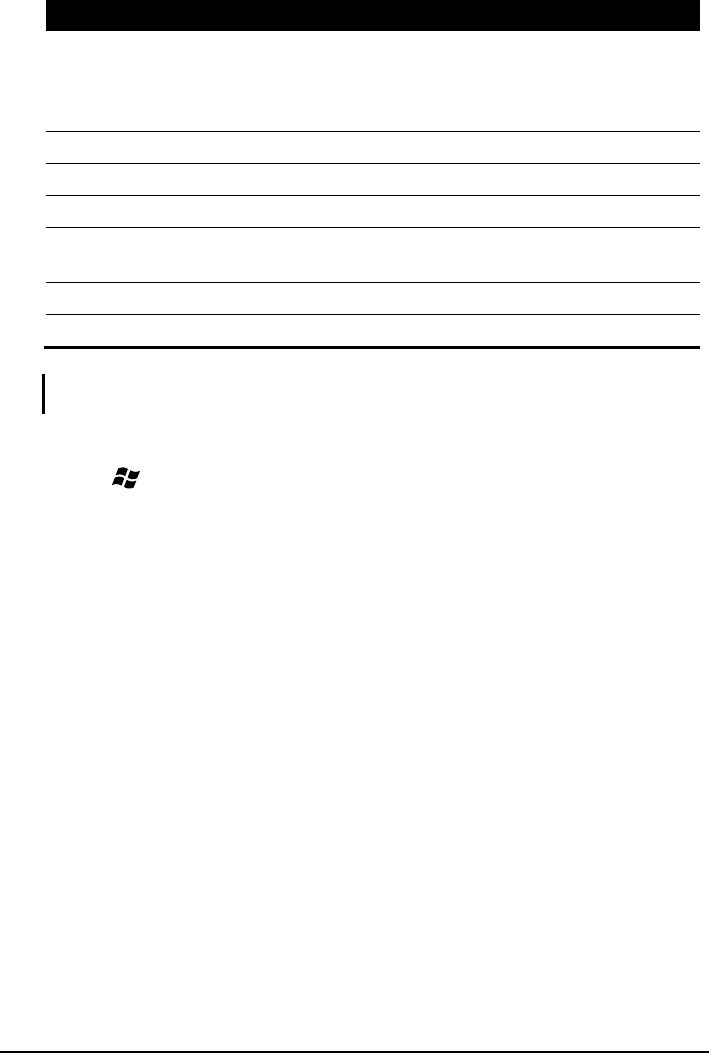
52
NOTE: By default, the display area blanks out and shows the word “Standby” when the
camera has been idle for one minute. To resume, tap the screen.
3. Aim the camera lens at the subject. Press the program button 1 (the one
labeled ) for automatic focusing. A white frame appears. Wait until the
color of the frame turns green indicating the subject is in focus.
4. Press the navigation stick to take the picture.
5. The result shows on the screen if the picture was taken in Normal or Timer
mode. At this time, you can tap Menu to perform a desired task to the
current picture. Tap Camera or ok to go back to the Camera screen.
6. The picture is saved to the predefined storage location (as long as you didn‘t
delete it in the previous step).
Menu Items
Descriptions
Mode
Three choices:
1. Normal
2. Burst – Continuous shooting of 5 pictures
3. Timer – 5 second countdown before shooting
Brightness
Seven brightness levels
Resolution
Six choices from 160x120 to 2048x1536 (640x480 by default)
Zoom
Available choices depend on the resolution.
White
Balance
Five choices from which you can select one that matches the
current light source.
Full Screen
Full screen on and off.
Options
Overall settings to the Camera program.
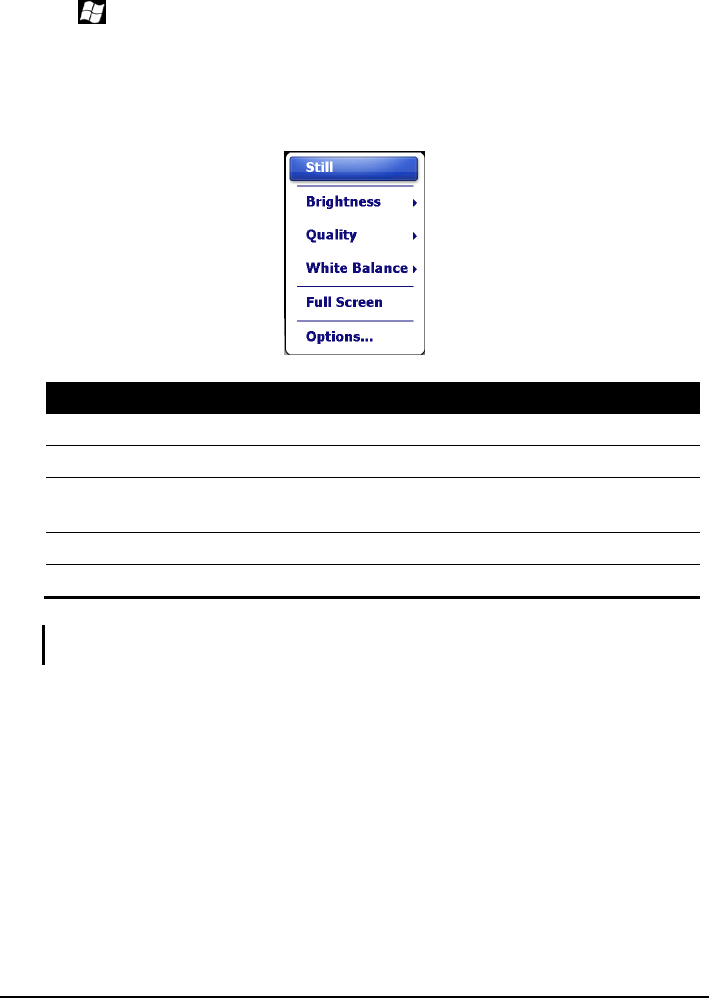
53
Recording Video Clips
1. Tap Pictures & Videos Camera.
2. Tap Menu Video to switch to the video mode. Below the display area are
indicators of the current status.
3. For recording controls such as brightness and white balancing, tap Menu.
NOTE: By default, the display area blanks out and shows the word “Standby” when the
camera has been idle for one minute. To resume, tap the screen.
4. Press the navigation stick to start recording.
If needed, you can tap Pause to temporarily pause the recording and then tap
Resume to continue.
Menu Items
Descriptions
Brightness
Seven brightness levels
Quality
176 x144
White
Balance
Five choices from which you can select one that matches the
current light source.
Full Screen
Full screen on and off.
Options
Overall settings to the Camera program.
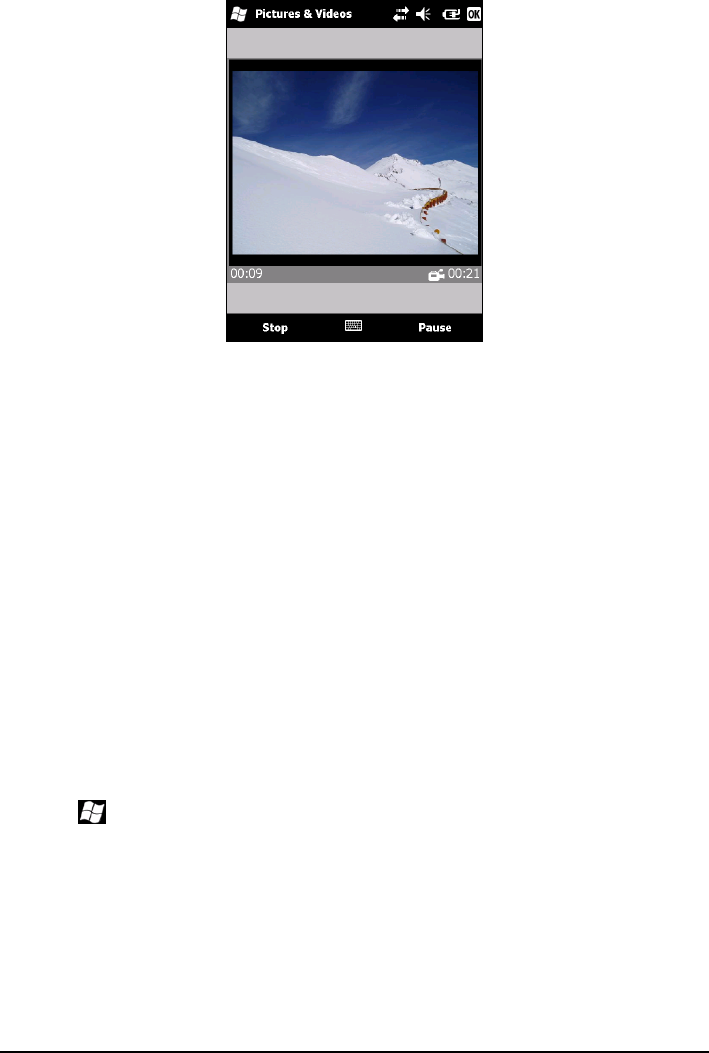
54
5. To stop, press the navigation stick or tap Stop.
Or, the recording will automatically stop when the length reaches the
pre-defined maximum value (30 seconds by default).
6. The video clip is saved to the predefined storage location. To view the video
clip, tap Thumbnails.
Camera Controls, Options, and Settings
While taking pictures or recording video clips, you can tap Menu to use a function
that meets your specific need.
For one time overall settings to the Camera program, you need to access two
different places for different settings:
While in the Camera program, tap Menu Options. Make the necessary
changes. Tap ok when finished. The changes take effect immediately.
Tap Settings System Camera Settings. Make the necessary
changes. Tap ok when finished. The changes take effect only when you next
start the Camera program.
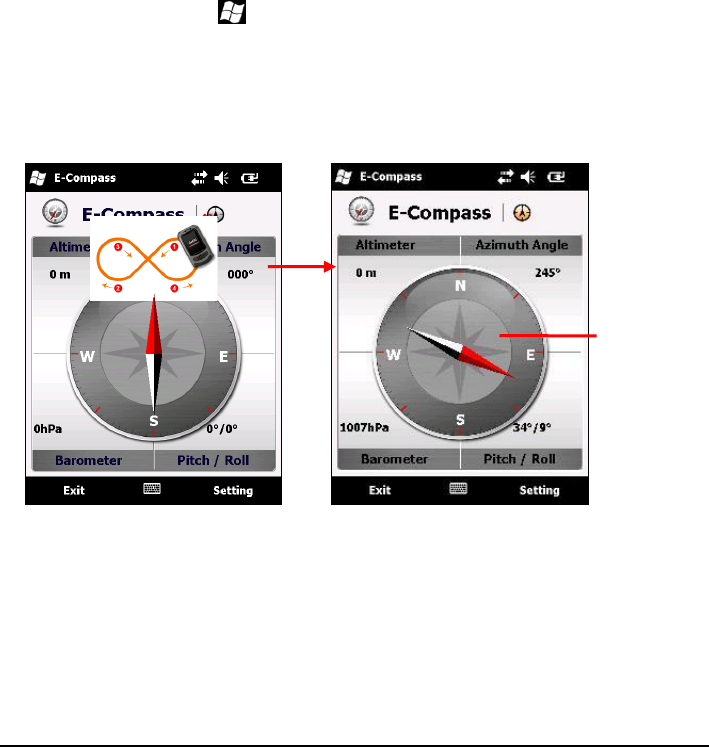
55
5.8 Additional Programs
In addition to Microsoft software, your Pocket PC manufacturer may provide
additional programs to enhance your Pocket PC or facilitate your operation.
E-Compass
The E-Compass program shows directions of movement including heading,
pitch angle, roll angle, and altitude.
Reading and Calibrating the Compass
To run the program, tap E-Compass.
Each time you start the program, you‘ll be requested to calibrate the compass.
Hold the device in your palm and swing it in the way as shown in the small
popup window on the screen. Do this several times until the popup window
disappears.
To exit the program, tap Exit at the bottom left of the screen.
Needle on the
compass dial
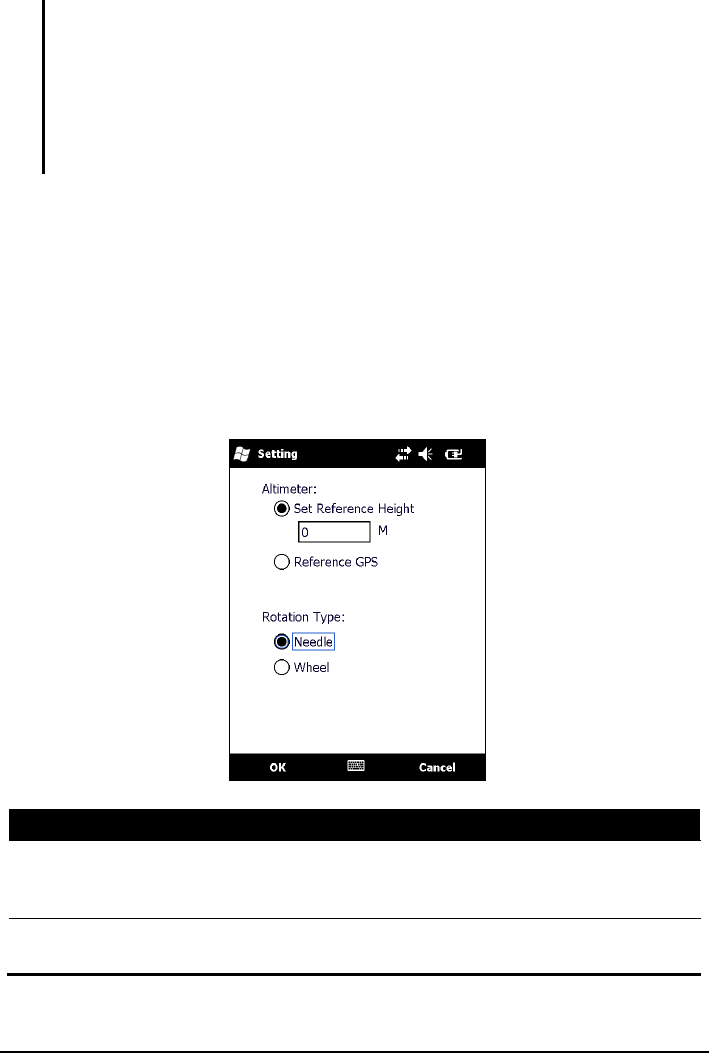
56
NOTE: Follow these guidelines when using the compass.
Keep the device away from objects that generate magnetic fields, such as cars, large
belt buckles, computers, cell phones, etc.
If you must use the compass inside a car, the device should be at least 20 cm (7.87
inches) away from metal objects such as car doors, dashboard, air vents, etc.
Avoid playing the MP3 music with the internal speaker or connecting the AC adapter.
This will cause the magnetic interference to the compass.
Regularly set the reference altitude for an accurate output. (See the next section.)
Compass Settings
The value of altitude is adjusted according to the change in the ambient pressure.
It is important that you regularly set the reference altitude because the compass
needs an appropriate starting point (altitude versus ambient pressure) for future
adjustments.
To configure the compass, tap Setting Setting. When finished, tap OK to save
the changes and go back to the Compass screen.
Setting Items
Descriptions
Altimeter
Set the reference altitude for the compass. You can either set a
specific height (zero by default) or use GPS positioning as the
reference (GPS positioning will be initiated after you tap OK).
Rotation Type
Set to Needle for a pivoting needle on a fixed dial or Wheel for a
fixed needle on a rotating dial.

57
Tap OK to save the changes and go back to the Compass screen.
TacLink
The TacLink program receives GPS satellite signals to calculate the location of
your device. You can also record a NMEA log file for the use of other
applications.
Running TacLink
To run the program, tap TacLink.
A message appears if positioning is not completed in 10 minutes.
To exit the program, tap Exit at the bottom left of the screen.
NMEA Log
To start logging, tap Setting Log Start. To stop, tap Setting Log Stop.
For each logging section, new data is added to the end of the existing data in the
same file. By default, the log file is named ―GeTACGPSLog‖ and saved to ―My
Documents‖ folder on your device. To specify a different name and location for
file, tap Setting Log File.
Shows the overhead
satellite positions.
Shows the signal strength
of the satellites.
Shows the result of GPS
positioning. A minimum of 4 GPS
satellite signals is needed to
calculate your GPS position.
A red X indicates logging is not activated.
No X indicates logging is activated.
This icon appears only if SBAS is
enabled. (See the next section for
information.)
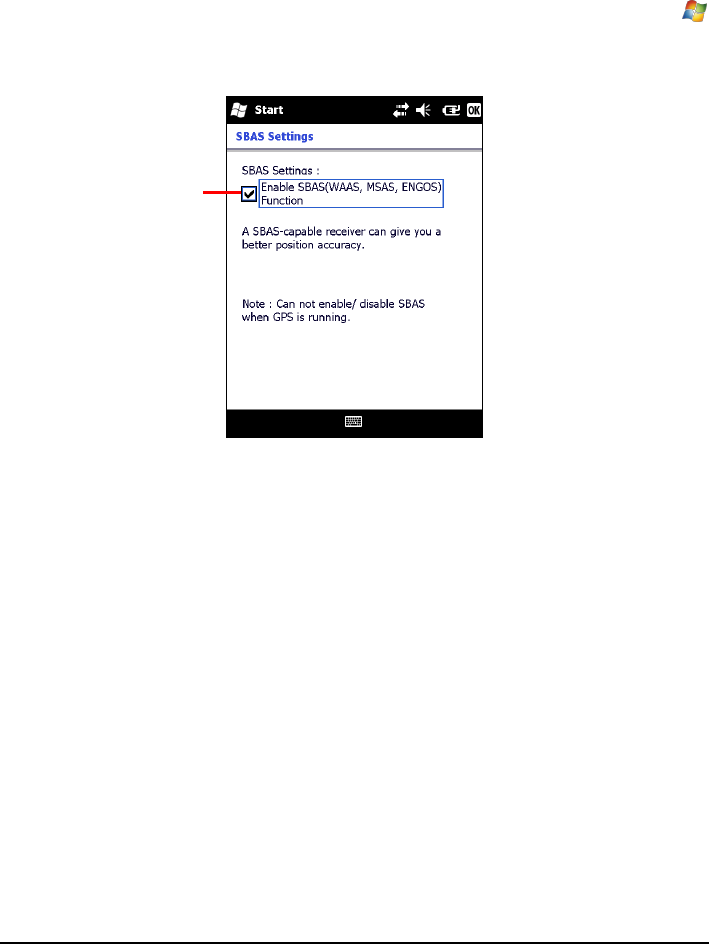
58
SBAS Settings
SBAS (WAAS, MSAS, ENGOS) provides additional accuracy and reliability
for the GPS devices. Ground stations are necessary to achieve the purpose.
The SBAS feature works where such stations exist. To enable the feature, tap
Settings System GPS Advanced. Tap the checkbox to enable or disable
the SBAS function. A check () indicates enabled.
Tap ok when finished. If you change the setting while a GPS program (such as
TacLink) is running, the change takes effect only after you exit the GPS program
and then start it again.
Tap the checkbox to
enable or disable the
function. A check ()
indicates enabled.
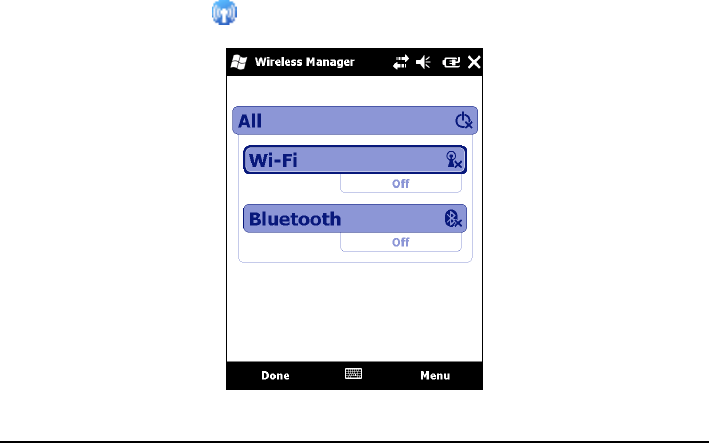
59
6 Getting Connected
To take full advantage of your Pocket PC, you will want to get connected. This
chapter tells you how you can get your Pocket PC connected through a variety of
ways.
6.1 Wireless Network Connection
Your Pocket PC has a built-in wireless network module. As long as you are in a
wireless LAN environment, you can connect to the network without physical
cables.
Turning On and Off the Wi-Fi Radio
By default, the Wi-Fi radio is turned off. To turn on the Wi-Fi radio, follow this
procedure:
1. Tap the Wi-Fi icon on the Today screen to access Wireless Manager.
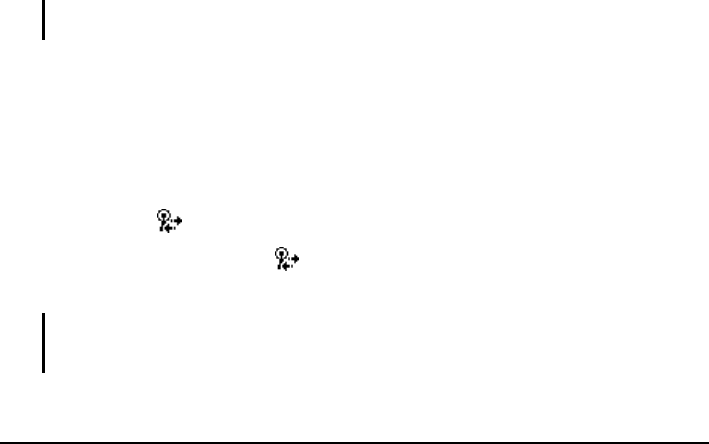
60
2. Tap the Wi-Fi box to change the Wi-Fi radio status from Off to Available.
The Wi-Fi radio status on the Today screen indicates Available.
To turn off the Wi-Fi radio, follow the above procedure, but tap the Wi-Fi box to
change the Wi-Fi radio status from Available to Off. The Wi-Fi radio status on the
Today screen indicates Off.
Connecting to a Wireless Network
1. Turn on the Wi-Fi radio. (See ―Turning On and Off the Wi-Fi Radio‖
previously in this chapter.)
2. Tap Menu Wi-Fi Settings to open the Wireless Networks Configuration
screen. By default, your Pocket PC will automatically detect the available
wireless networks.
3. If more than one network is detected, the screen will display a network list.
Tap the desired network and follow the procedure to configure the wireless
network.
4. Tap Finish to end the configuration, and tap the Connect soft key to connect to
the Internet or the private network.
5. If the selected network requires a network key, enter the key and tap the
Connect soft key.
NOTE: You can tap the network any time to open the Wireless Network Configuration
screen and change the network settings.
Starting and Ending the Wireless Network Connection
After you connect to the wireless network, use the desired program when you are
within the range of the wireless network. For example, switch to Internet
Explorer Mobile and browse to a web page. Your Pocket PC will automatically
connect, and the icon will appear on the navigation bar.
To end the connection, tap the icon on the Navigation Bar of the Today
screen Wireless Manager Wi-Fi.
NOTE: When you are not using the wireless network any more, complete the actions for
ending the connection as described above. Leaving the wireless network module active will
consume more power.
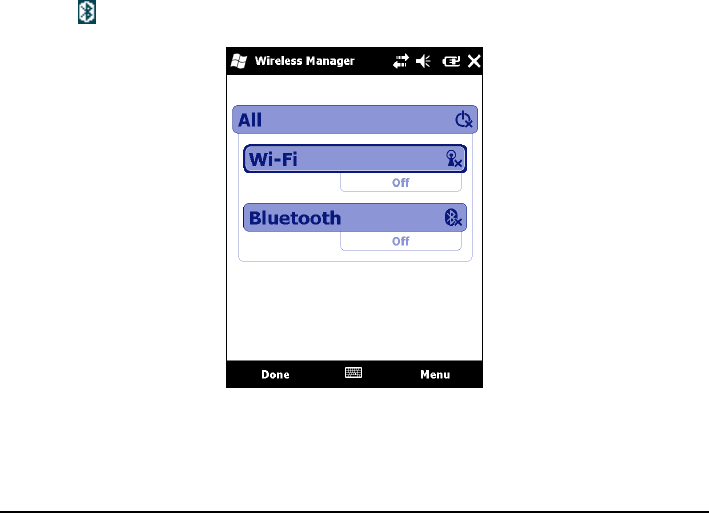
61
6.2 Bluetooth Feature
Your Pocket PC incorporates the Bluetooth capability. Bluetooth technology is a
short-range wireless communications technology. Devices with Bluetooth
capabilities can exchange information over a distance of about 10 meters (30
feet) without requiring a physical connection.
You can use Bluetooth technology as follows:
Beam information, such as files, appointments, tasks, and contact cards,
between devices that have Bluetooth capabilities.
Create a connection between your Pocket PC and a Bluetooth phone to use
the phone as a modem.
Use a Bluetooth service. Once you connect to another device or computer
using Bluetooth technology, you can locate and use any of the services
available on that device.
Turning On and Off the Bluetooth Radio
By default, Bluetooth is turned off. To turn on Bluetooth, follow this procedure:
1. Tap on the Today screen to access Wireless Manager.
2. Tap the Bluetooth box to change the Bluetooth radio status from Off to On.

62
For other devices with Bluetooth capabilities to detect your Pocket PC and
attempt to beam information to it, establish a partnership, or use a Bluetooth
service, tap Menu Bluetooth Settings Mode Make this device visible to
other devices. The Bluetooth radio status indicates Visable.
The Bluetooth radio status on the Today screen indicates On.
To turn off the Bluetooth radio, follow the above procedure, but tap the Bluetooth
box to change the Bluetooth radio status from On or Visable to Off. The Bluetooth
radio status on the Today screen indicates Off.
NOTE:
By default, the Bluetooth radio is turned off. If you turn it on, and then turn off your Pocket
PC, the Bluetooth radio also turns off. When you turn on your Pocket PC again, the
Bluetooth radio turns on automatically.
When you have finished using the Bluetooth radio, complete the actions for turning it off.
Leaving the Bluetooth capability active will consume more power.
Transferring Files via Bluetooth Technology
Sending Files via Bluetooth Technology
1. Turn on the Bluetooth radio. (See ―Turning On and Off the Bluetooth Radio‖
previously in this chapter.)
2. Make sure that your Pocket PC and the device that is receiving the
information are within close range, and that device is discoverable.
3. From the program, tap and hold the item you want to beam, such as an
appointment in Calendar, a task in Tasks, a contact card in Contacts, or a file
in File Explorer.
4. Tap Beam [type of item] on the shortcut menu.
5. Your Pocket PC searches for other devices with Bluetooth capabilities
within close range, and displays them in the list. Tap the device to which you
want to send the item.
Receiving Files via Bluetooth Technology
1. Tap Settings Connections Beam. Make sure that Receive all
incoming beams is selected.

63
2. Make sure that Make this device visible to other devices in Bluetooth settings is
selected. (See ―Turning On and Off the Bluetooth Radio‖ previously in this
chapter.)
3. Make sure that your Pocket PC and the device that is beaming the
information are within close range, and that device is discoverable.
4. When prompted to receive an incoming beam, tap Yes to receive the beamed
information.
Bluetooth Partnership
A partnership is a relationship that you create between your Pocket PC and
another device with Bluetooth capabilities to help exchange information in a
secure manner. Creating a partnership involves entering the same Bluetooth
passkey on both devices. Once a partnership is created, the devices need only
have the Bluetooth radio turned on to exchange information; they do not need to
be discoverable.
Creating a Bluetooth Partnership
1. Make sure that the two devices are turned on, discoverable, and within close
range. (See ―Turning On and Off the Bluetooth Radio‖ previously in this
chapter.)
2. Tap on the Today screen to access Wireless Manager.
3. Tap Menu Bluetooth Settings Devices Add new device.
4. Your Pocket PC searches for other devices with Bluetooth capabilities, and
displays them in the list.
5. Tap the name of the other device, and tap Next.
6. In Passcode, enter an alphanumeric passkey between 1 and 16 characters,
and tap Next.
7. Enter the same passkey on the other device.
8. Tap Done.
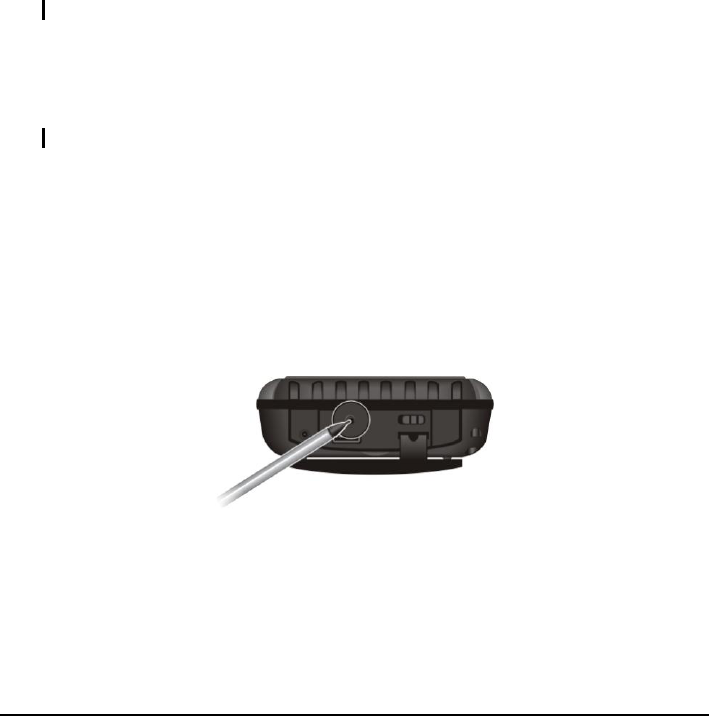
64
7 Troubleshooting and
Maintenance
This chapter gives solutions to common Pocket PC problems you may
encounter. It also provides guidelines on taking care of your Pocket PC.
NOTE: If you encounter a problem you cannot solve, contact your dealer for assistance.
7.1 Resetting Your Pocket PC
CAUTION: Resetting will cause unsaved data to be lost.
Resetting your Pocket PC allows you to restart the operating system, but you will
lose any unsaved data.
Occasionally, you may need to reset your Pocket PC; for example, you should
reset your Pocket PC when it stops responding. In other words, it appears to be
―frozen‖ or ―locked up.‖
Use the stylus to press the reset button on your Pocket PC
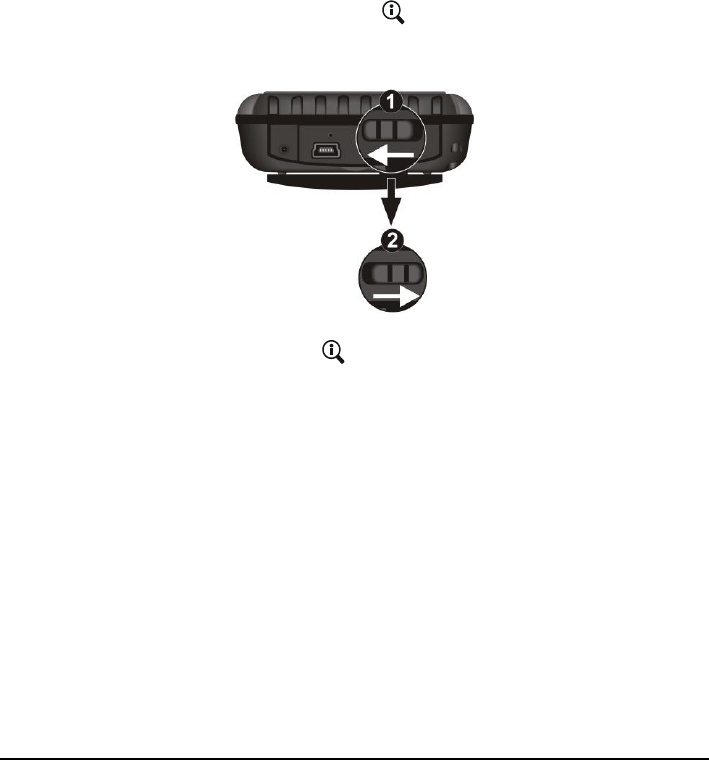
65
7.2 Restoring the Factory Default State
In some cases, you may need to restore your Pocket PC to the factory default
state by clearing the memory (RAM) from your Pocket PC. For example, you
should clear the memory:
When your Pocket PC does not respond after being reset.
When you forget your password.
Clearing the memory means all data you have entered in RAM, including all
files, system settings and additional programs you have installed, will be erased.
1. Press and hold the upper right button ( ) of your Pocket PC.
2. Slide the ON/OFF switch off and then slide it on again.
3. Release the upper right button ( ) of your Pocket PC after ―Clean boot
now‖ appears on screen.
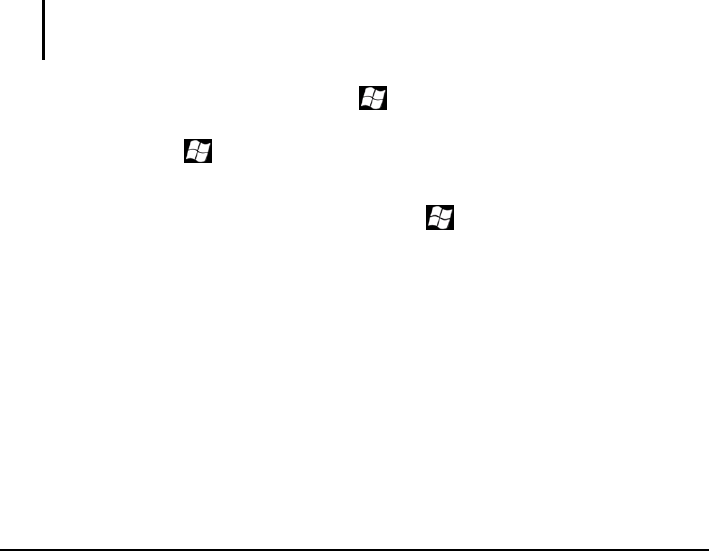
66
7.3 Troubleshooting
Power Problems
Power does not turn on when using battery power
The remaining battery power may be too low to run your Pocket PC.
Connect the AC charger to your Pocket PC and to external AC power. Then,
turn on your Pocket PC.
Battery runs out of power quickly
You might be using your Pocket PC in ways that drain power quickly. (See
―Power-Saving Tips‖ in Section 3.1 for more information.)
Memory Problems
If a warning message of not enough memory appears due to the memory
allocation problem, try the following to free memory on your Pocket PC.
CAUTION: Be discreet when you delete files. Deleting files of which the function is
unknown can cause programs or features to malfunction. It is appropriate to make a backup
before deleting files.
Delete files you no longer need. Tap File Explorer. Tap and hold the file
you wish to delete and then tap Delete on the shortcut menu. To find your
largest files, tap Search Phone. In the Type list, tap Larger than 64KB
Search.
Remove programs you no longer need. Tap Settings System
Remove Programs. Tap the program you want to remove and then tap Remove.
In Internet Explorer options, delete all files and clear history.

67
Stop programs you are not currently using. In most cases, programs
automatically stop to free needed memory. However, in some situations, such
as when confirmation dialog boxes are waiting for a user response, the
program may not be able to automatically stop. To check the state of your
active programs, tap Settings System Task Manager. Tap the
program you want to view and then tap Refresh. Close any open windows or
messages and return the program to list view. If this does not work, you can
stop the program manually. First, make sure that your work is saved by
closing open items and returning the program to list view. Then, stop the
program by tapping End Task.
Reset your Pocket PC as described in Section 7.1.
If you have a storage card, move data to the storage card as described
next.
Tap File Explorer. Use the File Explorer to move the file to the correct
location of the storage card.
Move email attachments. In E-mail, tap Menu Tools Options Storage
and select When available, use this storage card to store attachments. All
attachments are moved to the storage card and new attachments are
automatically stored on the storage card.
Set programs such as Notes, Word Mobile and Excel Mobile to
automatically save new items on the storage card. In the program, tap Menu
Options. In Save to, select Storage Card.
Screen Problems
Screen is off
If the screen does not respond even after you press the power button, try the
following in order until the problem is solved:
Connect the AC charger to your Pocket PC and to external AC power.
Reset your Pocket PC as described in Section 7.1.

68
Screen responds slowly
Make sure that your Pocket PC is not running out of battery power or
running many active programs. If the problem still exists, reset your Pocket
PC as described in Section 7.1.
Screen freezes
Reset your Pocket PC as described in Section 7.1.
Inaccurate response to stylus taps
Realign the touch screen. Tap Settings System Screen Align
Screen.
Connection Problems
ActiveSync Connection Problems
ActiveSync connection problems may occur in some specific cases. They
are likely caused by interoperability with desktop firewall applications or
applications that manage network traffic. For troubleshooting information,
visit the Microsoft web site.
Make sure that you have installed the correct version of ActiveSync on your
desktop computer. Install the version ActiveSync included with your Pocket
PC.
Make sure that your Pocket PC and your desktop computer are both turned
on before establishing the connection.
Make sure that the cable is securely plugged into the USB port on your
desktop computer. Connect the USB cable directly to your desktop
computer—do not run the cable through a USB hub.
Make sure that the USB connection is enabled in ActiveSync on your
desktop computer. If the USB connection is already enabled, disable the
USB connection, close the Connection Settings window and then reopen and
re-enable the USB connection.
Reset your Pocket PC before connecting the cable. (See Section 7.1.)
Always disconnect your Pocket PC before you restart your desktop
computer.

69
Connect only one Pocket PC or personal digital assistant to your desktop
computer at a time.
Network Connection Problems
Make sure that you have added necessary server information.
If Network Connection is not listed as a connection method in the ActiveSync
dialog box when starting synchronization, wait a few minutes and try again.
Also, if synchronization does not start right away, the network is probably
busy, and it may take a minute for your Pocket PC to connect to the network.
Verify with your network administrator that your user name and password
are correct.
Verify with your network administrator that the network you are trying to
connect to is available, to try to connect to it from another computer.
You may need to change the device name if you are trying to connect to a
network and cannot because another device with the same name is already
connected. To change the device name, tap Settings System About
Device ID.
7.4 Taking Care of Your Pocket PC
Taking good care of your Pocket PC will ensure trouble-free operation and
reduce the risk of damage to your Pocket PC.
General Guidelines
Keep your Pocket PC away from excessive moisture and extreme
temperatures.
Avoid exposing your Pocket PC to direct sunlight or strong ultraviolet light
for extended periods of time.
Do not place anything on top of your Pocket PC or drop objects on top of
your Pocket PC.
Do not drop your Pocket PC or subject it to severe shock.
Store your Pocket PC in a protective cover when not in use.

70
Do not subject your Pocket PC to sudden and severe temperature changes.
This could cause moisture condensation inside the unit that could damage
your Pocket PC. In the event of moisture condensation, allow you Pocket PC
to dry out completely.
Take care not to sit on your Pocket PC when it is located in the back pocket
of trousers, etc.
The screen surface is easily scratched. Use only the stylus to tap on the
screen. Avoid touching it with your fingers, pens, pencils or any other sharp
objects.
Never clean your Pocket PC with its power on. Use a soft, lint-free cloth to
wipe the screen and the exterior of your device.
Do not use paper towels to clean the screen.
Never attempt to disassemble, repair or make any modifications to your
Pocket PC. Disassembly, modification or any attempt at repair could cause
damage to your Pocket PC and even bodily injury or property damage.
Do not store or carry flammable liquids, gases or explosive materials in the
same compartment as your Pocket PC, its parts or accessories.
Travel Guidelines
Before traveling with your Pocket PC, back up your data. As an added
precaution, bring along a backup copy.
Turn off your Pocket PC and disconnect all external devices.
Make sure that the battery is fully charged.
Take the AC charger with you. Use the AC charger as the power source and
as a battery-recharger.
Keep your Pocket PC inside its protective cover when you are not using it on
the road.
Hand-carry your Pocket PC in a protective cover. Do not check it in as
luggage.
If you plan to travel abroad with your Pocket PC, consult your dealer for the
appropriate AC charger for use in your country of destination.

71
If you plan to make modem connections abroad, make sure that you have the
correct modem and cable for your country of destination.

72
8 Regulatory Information
NOTE: Marking labels located on the exterior of your device indicate the regulations that
your model complies with. Please check the marking labels on your device and refer to the
corresponding statements in this chapter. Some notices apply to specific models only.
8.1 Regulations Statements
European Notice
Products with the CE marking comply with Radio & Telecommunication
Terminal Equipment Directive (R&TTE) (1999/5/EEC), the Electromagnetic
Compatibility Directive (89/336/EEC) and the Low Voltage Directive
(73/23/EEC) – as amended by Directive 93/68/ECC – issued by the Commission
of the European Community.
Compliance with these directives implies conformity to the following European
Standards:
EN301489-1: Electronic compatibility and Radio spectrum Matters (ERM),
ElectroMagnetic Compatibility (EMC) standard for radio equipment and
services; Part 1: Common technical requirements
EN301489-17: Electronic compatibility and Radio spectrum Matters (ERM),
ElectroMagnetic Compatibility (EMC) standard for radio equipment and
services; Part 17: Specific conditions for 2.4 GHz wideband transmission
systems and 5 GHz high performance RLAN equipment
EN55022: Radio disturbance characteristics
EN55024: Immunity characteristics
EN6100-3-2: Limits for harmonic current emissions
EN6100-3-3: Limitation of voltage fluctuation and flicker in low-voltage
supply system
EN60950 / IEC 60950: Product Safety

73
The manufacturer cannot be held responsible for modifications made by the User
and the consequences thereof, which may alter the conformity of the product
with the CE Marking.
FCC CAUTION
This device complies with part 15 of the FCC Rules. Operation is subject to the
following two conditions: (1) This device may not cause harmful interference,
and (2) this device must accept any interference received, including interference
that may cause undesired operation.
This device has been tested and found to comply with the limits for a Class B
digital device, pursuant to Part 15 of the FCC Rules. These limits are designed to
provide reasonable protection against harmful interference in a residential
installation. This equipment generates uses and can radiated radio frequency
energy and, if not installed and used in accordance with the instructions, may
cause harmful interference to radio communications. However, there is no
guarantee that interference will not occur in a particular installation If this
equipment does cause harmful interference to radio or television reception,
which can be determined by turning the equipment off and on, the user is
encouraged to try to correct the interference by one or more of the following
measures:
-Reorient or relocate the receiving antenna.
-Increase the separation between the equipment and receiver.
-Connect the equipment into an outlet on a circuit different from that to which
the receiver is connected.
-Consult the dealer or an experienced radio/TV technician for help.
Changes or modifications not expressly approved by the party responsible for
compliance could void the user‗s authority to operate the equipment.
The antenna(s) used for this transmitter must not be co-located or operating in
conjunction with any other antenna or transmitter.

74
8.2 Safety Precautions
Prolonged listening of music in maximum volume can damage the ears.
The use of headphones other than those recommended/supplied can cause
hearing impairment due to excessive sound pressure.
About Charging
Use only the AC adapter (PSC11R-050) supplied with your Pocket PC. Use
of another type of AC adapter will result in malfunction and/or danger.
Use only the car charger supplied by the manufacturer. Use of another type
of car charger will result in malfunction and/or danger.
This product is intended to be supplied by a LISTED Power Unit marked
with ―LPS,‖ ―Limited Power Source,‖ and output rated + 5 V dc / 2.0 A.
Use a specified cradle approved by the manufacturer.
Use a specified battery in the equipment.
About the Charger
Do not use the charger in a high moisture environment. Never touch the
charger when your hands or feet are wet.
Allow adequate ventilation around the charger when using it to operate the
device or charge the battery. Do not cover the charger with paper or other
objects that will reduce cooling. Do not use the charger while it is inside a
carrying case.
Connect the charger to a proper power source. The voltage and grounding
requirements are found on the product case and/or packaging.
Do not use the charger if the cord becomes damaged.
Do not attempt to service the unit. There are no serviceable parts inside.
Replace the unit if it is damaged or exposed to excess moisture.

75
About the Battery
Use a specified charger approved by the manufacturer.
Do not mutilate, puncture, or dispose of battery in fire. The battery can burst
or explode, releasing hazardous chemicals.
Important instructions
Caution: Risk of explosion if battery is replaced by an incorrect type.
Dispose of used batteries according to the instructions.
Replace only with the same or equivalent type recommended by the
manufacturer.
The battery must be recycled or disposed of properly.
Use the battery only in the specified equipment.
About the Radio Frequency Exposure
This product is a low-power radio transmitter and receiver. When it is turned on,
it receives and also sends out radio frequency (RF) signals. Specific Absorption
Rate (SAR) is the unit of measurement for the amount of radio frequency energy
absorbed by the body. The highest SAR value for this product when tested for
use is 0.066W/kg, lower than the limit of 1.6 W/kg.
For body worn operation, this device has been tested and meets the FCC RF
exposure guidelines for use with an accessory that contains no metal and the
positions the handset a minimum of 1.5 cm from the body. Use of other
accessories may not ensure compliance with FCC RF exposure guidelines.